#amitabha
Text
Sun Wukong's Buddhist Paradise
Some of my followers may be familiar with my past article in which I described Xuanzang's historical itinerary and discussed what a more realistic Journey to the West might be like. Towards the end, after the pilgrims return to China with the scriptures and the disciples (Sun Wukong, Zhu Bajie, and Sha Wujing) receive their elevation in spiritual rank, I stated: “They would thereafter leave to enjoy their divine lives in the Western Paradise.” But I’ve never really liked the idea that Monkey would forever abandon his people. This is especially true since his rebellion led to heaven decimating the monkeys and burning their cave (Wu & Yu, 2012, vol. 2, p. 31).
I think a better ending for this historical version would be for the “Victorious Fighting Buddha” to return to the Mountain of Flower and Fruit, where he transforms it into his own Pure Land (Jingtu, 淨土). The monkeys killed in years passed would be reborn there, and everyone would receive periodic lessons on the dharma between bouts of play. It would be a paradise even grander than when the Great Sage was at the height of his power.
Here is some information about pure lands from the Encyclopedia of Buddhism (Gomez, 2004):



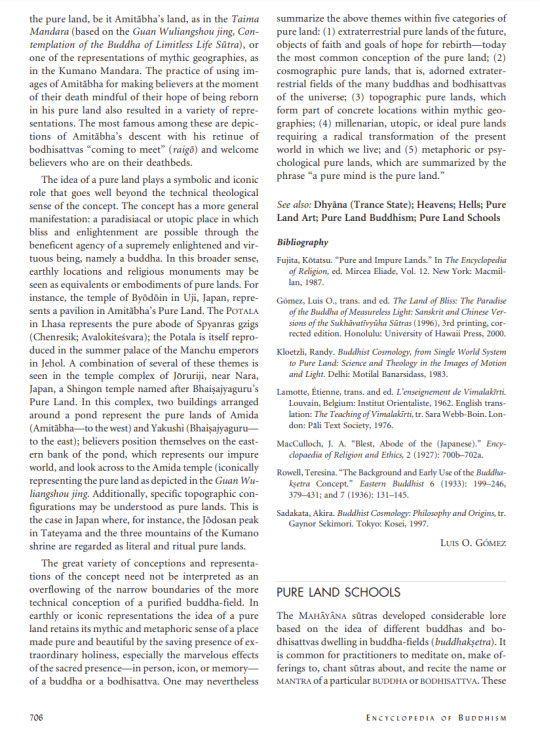
I love this circa 1700 Tibetan painting of Amitabha in his pure land of Sukhavati. Just imagine the Victorious Fighting Buddha sitting in Amitabha's place, and monkeys would take the place of the monks, protectors, and devas.

Sources:
Gomez, O. L. (2004). Pure Lands. In R. E. Buswell (Ed.), Encyclopedia of Buddhism (pp. 703-706) (Vols. 2). United Kingdom: Macmillan Reference, USA.
Wu, C., & Yu, A. C. (2012). The Journey to the West (Vols. 1-4). Chicago, Illinois: University of Chicago Press.
#sun wukong#monkey king#journey to the west#buddhism#Pure land#amitabha#Victorious Fighting Buddha#Buddha Victorious in Strife#Lego Monkie Kid#LMK#JTTW#dharma
75 notes
·
View notes
Photo

Buddha Amitābha (“Infinite Light”)
In Shingon Buddhism the mantra associated with this Buddha is:
oṃ amṛta tejehara hūṃ
Amṛta means “deathless”.
Tejehara is a compound of tejas, “bright”, and hara, “bringer”. This is close to the meaning of Latin Lucifer, the “Light Bringer”.
Amitābha is the ruler of a parallel universe, a pureland called Sukhāvatī, the “Sweet Realm”.
190 notes
·
View notes
Text
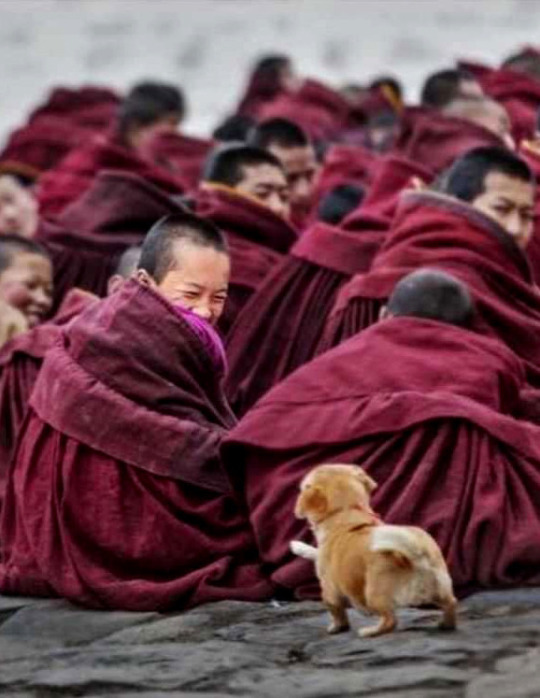
"Birds of a feather flock together. No matter what kind of friend you make, no matter how you associate with that person, you will eventually become like that person. That is what bonding is all about."
- Buddha (Udanavarga 25°I)
#buddha#buddhist#buddhism#dharma#sangha#mahayana#zen#milarepa#tibetan buddhism#thich nhat hanh#green tara#tanric#parinirvana#Padmasambhava#shantideva#amitabha#avalokitesvara#bodhicitta#dakini#dzogchen#heart sutra#guru rinpoche#Bodhisattva#vajrasattva#meditation#medicine buddha#merit#mind training#manjushri#mindfulness
128 notes
·
View notes
Text
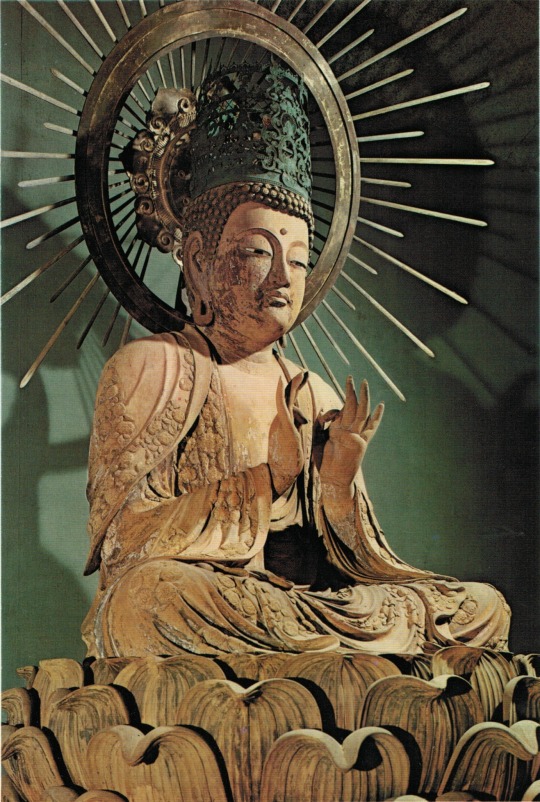
A sculpted image of Amida Buddha crowned (阿弥陀如来) dating to 1299 at Jōkōmyōji Temple (浄光明寺) in Kamakura, Kanagawa Prefecture
Image from "運慶と鎌倉彫刻 (日本の美術12)" [Unkei and Kamakura Sculpture (The Arts of Japan 12] by 水野敬三郎 [Mizuno Keisaburō], published by 小学館 [Shōgakukan], 1972, color plate 67
#japanese art#buddhist art#阿弥陀如来#amida#amitabha#神奈川県#kanagawa prefecture#鎌倉市#kamakura#浄光明寺#jokomyoji#真言宗#shingon#crazyfoxarchives#arte japonés#arte budista
46 notes
·
View notes
Text
Dharma Listening
One of the most important lessons I have learned from my experience of the Jodo Shinshu tradition is how to listen to the Dharma. I am utterly incapable of doing it properly, however. Still, when I have gleaned insight from it, it is because I could, for even a moment, truly hear what the words of the Dharma are saying.
When we read books, we are not just reading words off a page. We are conceptualizing the meanings of those words in their context on the page through our own lens. We never just read a book. We derive meaning from it by bringing our own biases to the reading.
This isn't always a bad thing. In fact, many creative authors rely on this to subvert the reader, creating an amazing story by tricking us into believing one meaning while communicating another. Authors also grapple with this problem of bringing our biases, and they become skilled at writing according to their audiences in order to facilitate a change of mind in the reader. Such twists and turns are what make reading, as well as other forms of media, fun and intellectually stimulating.
Authors who teach the Dharma must grapple with the same tendencies. And it is often difficult for new readers (like myself) to fully internalize what the author is saying because we either don't understand or don't *want* to understand what they are saying. There have been many times when I read a piece about Buddhism and simply ignored or discarded a line that doesn't suit my sensibilities. An example from Rennyo: "The mind/that even once/relies on Amida: that mind/is in accord/with the true Dharma."
This verse is from Rennyo Shonin's letters (Letter 4, Fascicle 4). It is truly a mind-boggling statement. The idea that such high attainment (being in accord with the true Dharma) is so easy (relying on Amida for a single moment) is hard to believe on its own. Yet it is at the core of Jodo Shinshu: With the one thought-moment of reliance, we are immediately saved by Amida from birth and death and are certain to be reborn in the Pure Land. So why is it so hard to believe?
When I read that line initially, I thought of...laziness. I thought of how such a view is lazy. Surely, this is a teaching for people who do not want to put in the work necessary for enlightenment, I thought to myself. And when I read it now, those thoughts still come up! However, they are also accompanied by a small joy that I have not experienced before. Even though my mind tries to scream and cry to drown the words out, I still "hear" them.
These thoughts come from a mindset that I brought to the text when reading it. In my life, people who don't want to work have been called lazy time and time again. I myself have done this, and I have also been called lazy myself. Growing up, this dichotomy of "lazy" versus "determined" was drilled into me from the cultural norm known as the "protestant work ethic." This is the attachment of value to hard work, especially concerning one's job. American folklore is filled with examples of this, from John Henry and Paul Bunyan to the myth of the self-made millionaire or billionaire in the modern day. But this is antithetical to what Rennyo is saying here, as well as other Jodo Shinshu writers going all the way back to Shinran.
Hearing these lines now, I must confess that I still struggle with this conflicting set of views. But I know that they are true. After all, the goal of a Buddha is to make others like themself: free from attachment and affliction and able to act with perfect wisdom and compassion. The best way to do that is to make a path that is so easy that anyone, regardless of capacity, could complete it. Hence, Amida realized the name and forged his vows to create this easy path.
In my mind, I'm immediately skeptical of shortcuts. And while the Jodo Shinshu path is still difficult in some ways, it is certainly easier. But here, the Buddha is saying, "Come on! I made this shortcut for you! Trust me, and you'll reach the other shore!" And I have to blame only myself and my preconceived biases for being hesitant.
Listening to the Dharma as someone new to Buddhism requires us to put aside our own views as best we can and open our minds to a new way of thinking about the world. Even if we disagree with what it is saying, we will only get the message if we can listen with an open mind. If we project our ideas onto the Dharma, we will just be reading a copy of our own thoughts. It is difficult, however, to put one's ideas aside and listen to something new with an open mind. After all, if detaching from our erroneous views were easy, then there would be no need for the many paths of Buddhism. Therefore, We should be thankful for authors who speak on the Dharma in ways that are designed to bring us to a new mode of thought from our current condition or in a way that is so plain and direct that misinterpretation becomes nearly impossible. I have found that many Jodo Shinshu figures, like Rennyo, Yuien-bo, and Shinran, fall within the latter category. As a result of reading them repeatedly, the walls of my own views are broken down by their straightforward words, which are easy to understand and digest. I cannot help but come to understand them, even when I am at the same time entrenched in my own views. This example is just one concept in Jodo Shinshu that is difficult to internalize, but I am happy to say that, little by little, I'm starting to get it.
20 notes
·
View notes
Text

Sri Amitābha Buddha, the embodiment of pure perception and Sunyata through infinite light.
18 notes
·
View notes
Text
The Real Lore Behind Douma’s Blood Demon Art: A Chinese and Japanese Buddhist Analysis

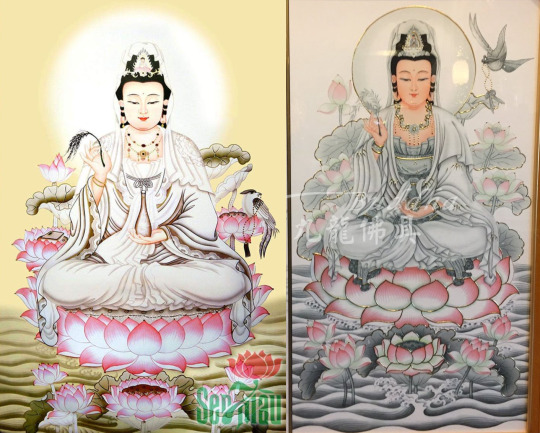
Water Lily Bodhisattva
Guanyin, Guan Yin or Kuan Yin is the Buddhist bodhisattva associated with compassion. She is the East Asian equivalent of Avalokiteśvara and has been adopted by other Eastern religions including Chinese folk religion.
Chinese Bodhisattva/ Goddess of Compassion, Mercy and Kindness is considered to be a mother-goddess and patron of seamen.
In Chinese Buddhism, Guan Yin is synonymous with the Bodhisattva Avalokitesvara, the pinnacle of mercy, compassion, kindness and love.
(Bodhisattva- being of bodhi or enlightenment, one who has earned to leave the world of suffering and is destined to become a Buddha, but has forgone the bliss of nirvana with a vow to save all children of god.)
Guanyin is the Chinese translation of Avalokiteshvara, the bodhisattva of compassion. Bodhisattvas are enlightened beings who chose to stay on earth as accessible examples for Buddhist faithful to follow.
As the Chinese Buddhist bodhisattva “Kuan-Yin embodies the Divine Feminine” (1) and is known as the “Great Mother of China”. (8) She is the goddess of fertility, of healing and of magic. She is a mother figure, a friend, a guide and a protector for women. She is what ever you need her to be. For it is her sacred task to “hear the cries of the world” and to answer them with love, mercy and compassion.
She is crossed-legged, looking at us with compassionate, kindly eyes. She seems the sort of person one might approach with a shameful confession or to receive sympathy after a rebuff from the world, when one is feeling defeated and without energy to put up the normal guard and pretences. She has a shawl across her fragile shoulders, a finely-sculpted chain around her neck and a lotus flower in the left hand. It’s early evening and a group of people have gathered around her, of varied ages and backgrounds, construction workers and business people, schoolgirls and bureaucrats. Some are mumbling, others smiling as one might at the sight of an old friend.

One goes to Guan Yin for relief from feelings of self-hatred. She is a little like an ideal friend or family member, an imaginary sister or mother. She suggests alternatives to despising oneself. She knows that benevolence towards others has to begin with self-acceptance. Her kindly eyes and smile have a habit of making one cry – for as we know from films, the moment one breaks down isn’t always or even mostly when one is facing overt hostility, rather when, after a period of hardship, one finally encounters kindness and space to admit to the difficulties one has been labouring with in stoic lonely silence for too long. One can be weak with Guan Yin, she isn’t impressed by the normal worldly criteria of success, there is no shame in crying in front of her and admitting the scale of one’s distress. She has the measure of the difficulties involved in trying to lead a halfway decent ordinary life.
Guan Yin is what Buddhists call a bodhisattva, and what Christians would call a saint. The Mayana branch of Buddhism to which Guan Yin belongs recognises many hundreds of bodhisattvas, usually historical figures, born in a variety of locations across Asia, whose qualities of character have earnt them a divine status. The bodhisattvas are mentioned in books and appear in paintings, but primarily, they feature as sculptures, three dimensional beings ranging in size from small dolls to light-housed sized giants and made in anything from rubber to wood to jade.

Just as Christian saints will approximate the goodness of Jesus, so the boddhisattvas are said to have a compassion and calm akin to the Buddha himself. And yet, like saints, individual bodhisattvas are revered for their talents in particular areas, there are bodhisattvas who care especially about animals, others who have an affinity for coping with physical pain, others still who understand the challenges of bringing up children.
Guanyin is the Buddhist counterpart to the Virgin Mary and she fulfills a similar role: that of hearing us in our distress, meeting us with tenderness and strengthening us to face the tasks of life. The centrality of these maternal figures in both Buddhism and Christianity suggests that mature adult lives share moments of deep self-doubt – and longings to recover some of the security of childhood. We need to be reassured that these wishes are not a sign that we have failed as human beings.

Although the tale from The Precious Scroll of Incense Mountain and popular interpretations depict her as a beautiful young woman robed in white, this was not the original depiction of Kuan Yin. According to the Lotus Sutra, the sacred second century Buddhist scripture, Kuan Yin was a handsome and princely Bodhisattva named Avalokitesvara. A Bodhisattva is not a god or a goddess. Neither is a bodhisattva a Buddha, but rather a Buddha-to-be, an earthly manifestation of the self-born and eternal Buddha Amitabha. According to Buddhist traditions, anyone who exhibits a Buddha-like quality, such as morality, self-sacrifice, and wisdom, has within themselves the ability to become a Buddha.
Although all Bodhisattvas are compassionate and merciful, Kuan Yin is considered to be the embodiment of these abstract principles. The original name of Avalokitesvara means “Lord who Looks Down” in Sanskrit, while Kuan Yin, or Guanyin, in Chinese means “the Perceiver of the Sounds of the World.” In the Lotus Sutra, Kuan Yin protects the world in the time between the departure of the historical Buddha, Siddhartha Gautama or Shakyamuni, and the appearance of the future Buddha, Maitreya. The sutra detailed Kuan Yin’s miraculous deeds, such as freeing people from lust, hatred, and ignorance, and granting children to infertile women. In order to achieve her goals, Guanyin has the ability to assume any form, male or female, human or non-human, adult or child, is required to teach Dharma, the way of the Buddha, and to relieve suffering

From the Song Dynasty in the tenth century onward, Kuan Yin representations began to transition toward the female form. Scholars believe that this change was due to the adoption of local religions and the incorporation of regional goddesses into Buddhism religious practices. In the Fujian region, for example, the prevalent depiction of Kuan Yin is as a young maiden dressed in Tang Hanfu carrying a fish basket, acting as the custodian of the local fishermen. However, the most accepted representation of Kuan Yin in China remains the image of a young woman wearing a flowing white robe with necklaces of Indian or Chinese royalty and a crown depicting the Amitabha Buddha.

Guan-Yin (Goddess of Fertility)
Guan-Yin, a.k.a. Kwan-Yin or Kuan-Yin, is a divinity presiding over pregnancy as well as safe and easy delivery of babies at birth. Regarded as the protector of children and women, Guan-Yin sits at times with a baby in her hands.
Although Guanyin's power of granting children is already mentioned in the Lotus Sütra, these indigenous scriptures are noteworthy on two accounts: they emphasize Guanyin's power to grant sons, and they also call attention to her protection of pregnant women and assurance of safe childbirths.
Today, Guanyin is revered as a compassionate savior, mother figure, and bestower of children. She is primarily worshipped by Chinese Buddhist women who request her assistance during pregnancy, while giving birth, and when attempting to conceive a child. She is also considered to be the principal female protector of pregnant women, fetuses, and young children.

Water Infinity and Symbolism
In addition to the feminization of Kuan Yin, local mythologies and religious symbols also began to appear in Kuan Yin statues and paintings. Artistic depictions of Kuan Yin often depicted her standing atop a dragon or a lotus flower, holding various water symbolic elements like a weeping willow branch, a jar of pure water or a lotus flower. The vase of pure water, often in the left hand, sometimes shown pouring water, is one of the Eight Symbols of Good Fortune in Chinese culture. The vase contains pure water capable of relieving suffering and sickness. The willow branch, frequently in the right hand, accompanying the vase of water, is used to sprinkle divine water. Willows hold significant meaning as they are often found by pond or lake, and are capable of bending without breaking.
The Lotus blossom is a common symbol of purity in the Buddhist religion. The lotus flower, although beautiful, began its life in the dark and muddy sediment of the pond. Human beings are identical: life starts in the darkness of ignorance, but through Dharma, or the way of the Buddha, thrive away from the dark and toward the light. Kuan Yin, Bodhisattvas, and Buddha are therefore often shown standing or seated on a large lotus flower floating above the water, signifying their achieved enlightenment.

Kuan Yin is also sometimes depicted surrounded by dragons. Unlike Western cultures, which commonly associate dragons with the fire element, in Eastern traditions, the dragon symbolizes flowing energy, water, and Chi. Statues of Kuan Yin may show her being surrounded by a sea of dragons to represent her spiritual connection to water and establish her as the patronesses of fishermen.
The title of "Goddess of Mercy" was eventually bestowed upon Kuan Yin by Jesuit missionaries toward the late Imperial China era. Christian travelers saw the innate connection between Kuan Yin and their own Virgin Mary; understandably so. The universal ideal of compassion is often associated with femininity and motherhood. Kuan Yin, believed to have the power to grant children to infertile women, is sometimes depicted with a child or accompanied by two young children, Shancai and Longnu.

Similarity to the Virgin Mary
Some Buddhist and Christian observers have commented on the similarity between Guanyin and Mary, mother of Jesus. This can be attributed to the representation of Guanyin holding a child in Chinese art and sculpture; it is believed that Guanyin is the patron saint of mothers and grants parents filial children, this apparition is popularly known as the "Child-Sending Guanyin" (送子觀音). One example of this comparison can be found in Tzu Chi, a Taiwanese Buddhist humanitarian organisation, which noticed the similarity between this form of Guanyin and the Virgin Mary. The organisation commissioned a portrait of Guanyin holding a baby, closely resembling the typical Catholic Madonna and Child painting. Copies of this portrait are now displayed prominently in Tzu Chi affiliated medical centres, especially since Tzu Chi's founder is a Buddhist master and her supporters come from various religious backgrounds.
During the Edo period in Japan, when Christianity was banned and punishable by death, some underground Christian groups venerated Jesus and the Virgin Mary by disguising them as statues of Kannon holding a child; such statues are known as Maria Kannon. Many had a cross hidden in an inconspicuous location. It is suggested the similarity comes from the conquest and colonization of the Philippines by Spain during the 16th century, when Asian cultures influenced engravings of the Virgin Mary, as evidenced, for example, in an ivory carving of the Virgin Mary by a Chinese carver.

Guan Yin is usually shown in a white flowing robe - white being the symbol of purity -, and usually wearing necklaces of Indian/Chinese royalty. In the right hand is a water jar (as the Sacred Vase the water jar also one of the Eight Buddhist Symbols of good Fortune) containing pure water, the divine nectar of life, compassion and wisdom, and in the left, a willow branch to sprinkle the divine nectar of life upon the devotees as to bless them with physical and spiritual peace. The willow branch is also a symbol of being able to bend (or adapt) but not break. The willow is also used in shamanistic rituals and has had medicinal purposes as well.
The crown usually depicts the image of Amitabha Buddha (Fully Conscious Infinite Light), Guan Yin's spiritual teacher before she became a Bodhisattva.
A bird, mostly a dove, representing fecundity is flying toward her.
A necklace or rosary is associated with her calls upon Buddha for succor, each bead of it representing all living beings and the turning of the beads symbolizes that Guan Yin is leading them out of their state of misery and repeated rounds of rebirth into nirvana, hence the beads represent enlightenment.
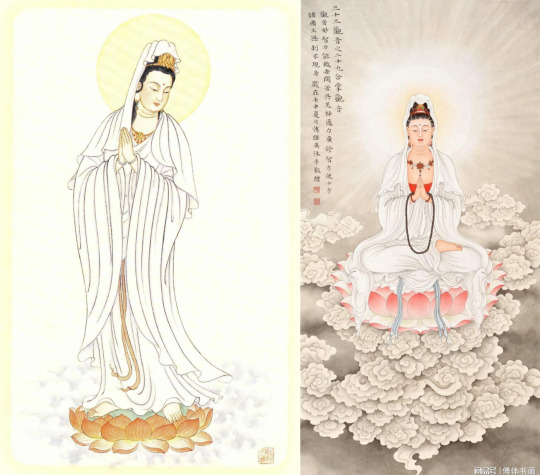
With the sweet dew drops she sprinkles from her vase, she relieves the suffering of beings everywhere and always, for countless autumns. In her hands she holds the vase of "sweet dew"; an elixir of compassion, the water of life, that relieves the suffering of all beings. In one hand she holds a small vase which contains Amitra “the dew of compassion” that is said to have the power to extend life, to cure and purify both body and mind when she pours or sprinkles it over human kind. A long life vase of healing waters: “sweet dew of compassion”. Of all the emblems that are sacred to Kuan-Yin it is water that is the most meaningful. When she bestows upon us her compassion it takes the form of rain or mystical showers sprinkled from her willow wand. Sprinkling sweet dews with a willow branch, she nourishes the entire dharma realm universally.
Miaoshan was her name: daughter of Miaozhuang; Princess of Zinglin, ‘The Raised Forest Kingdom’ in the far west. She was the youngest of three daughters. Without a male heir to continue the kingdom’s legacy, Miaoshan and her two sisters were forced into odious marriages by their father, king Miaozhuang. But unlike her sisters, Miaoshan was pure and, in her own way, stubborn. She believed that it was her life destiny to cultivate her spiritual essence and escape Samsara, the endless cycle of rebirth and suffering.

Unable to convince Miaoshan and further exasperated by her disobedience, King Miaozhuang eventually sent his contumacious daughter to be executed. Not long after, the king fell ill with a strange ailment. No physician in the kingdom or medicine from far off land could alleviate his malady. But a sagacious monk eventually appeared to the king; he apprised that the peculiar infirmity could only be mended by drinking an elixir made from the arm and eye of ‘one without anger.' The monk also informed the king of a hermit residing on Incense Mountain who was willing to make all the necessary donations.
The bizarre prescription was concocted; its effectiveness was instantaneous, and the king was promptly healed. Wanting to give thanks to his savior, the king made a pilgrimage to Incense Mountain. And to the king’s surprise, his savior was none other than Miaoshan, his daughter who had been miraculously saved from execution and was living a pious life atop the sacred mountain. The king fell before the maimed body of his daughter with penitence and begged for forgiveness. As tears were exchanged between father and daughter, Miaoshan transformed into a beautiful woman, robed in white, with one thousand arms and one thousand eyes. Miaoshan had obtained her enlightenment and escaped Samsara.
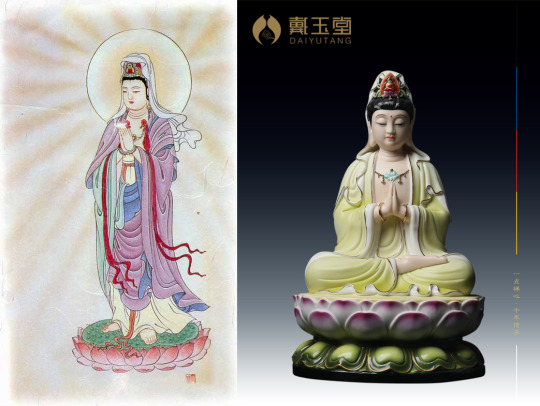
As she was about to enter the Pure Land Paradise, the Buddhism Heavenly Realm, Miaoshan heard a cry of anguish reverberating up from the world below. She looked around and saw a world filled with unbounded misery. Miaoshan could feel the gravity of a thousand worlds: each cry carrying countless lifetimes of sorrow. Miaoshan, now as the Thousand Armed Kuan Yin, turned her back to Heaven and took a vow of never leaving the Earth until all suffering has ended.
GUAN YIM AND THE THOUSAND ARMS
One Buddhist legend presents Guan Yin as vowing to never rest until she had freed all sentient beings from samsara, reincarnation. Despite strenuous effort, she realized that still many unhappy beings were yet to be saved. After struggling to comprehend the needs of so many, her head split into eleven pieces. Amitabha Buddha, seeing her plight, gave her eleven heads with which to hear the cries of the suffering. Upon hearing these cries and comprehending them, Guan Yin attempted to reach out to all those who needed aid, but found that her two arms shattered into pieces. Once more, Amitabha came to her aid and appointed her a thousand arms with which to aid the many.


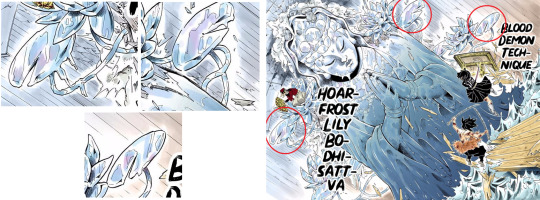
Turns out the “giant buddha” Douma invokes was actually a “woman” all along. I don’t even think there’s much room for debate with this one because Douma’s Water Lily Bodhisattva looks like a carbon copy of some Guanyin’s images out there. There are too many blatant references: the robe, the water lilies, the crown and the name of this technique. I’ve always found it curious how Douma’s “giant buddha” wears a robe/veil.
And let me inform/remind you that the version of the manga which’s available on the internet everywhere for everyone to read for free was translated by fans. I’m saying this because the translation for this technique does not exactly capture the original meaning. I tried to get a hold of the official Viz Media translation made by professional translators, but I couldn’t find it. However, I found the original japanese text and a very direct translation on the official KnY wikia:
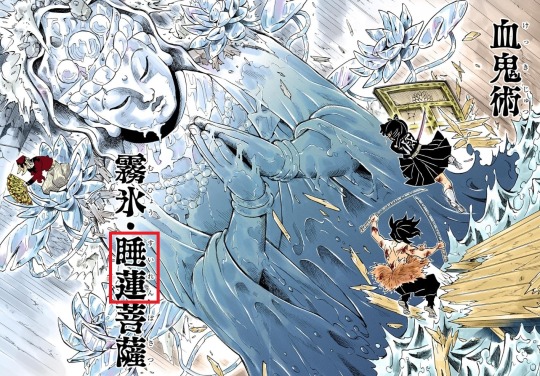

For those who want to search it themselves, 睡蓮(suiren) is “water lily” in japanese. If you put this word in a dictionary, you get “water lily” and if you copy and paste it on google images, you get lots of pictures of water lilies. I think Gotouge couldn’t have been more straight foward than “Water Lily Bodhisattva” unless if it was “Guanyin”. Guanyin isn’t a buddha yet, she’s still a bodhisattva and there are a ton of pictures of her where she’s surrounded by water lilies. Water lilies seem to be a recurring theme with her. I even created an album just about it on imgur. Bodhisattva is basically someone on the path to become a buddha. Some articles I’ve read compare a bodhisattva with a saint.



I think the freezing air Douma’s Water Lily Bodhisattva blows from its mouth might’ve been inspired by the healing water of sweet dew Guanyin sprinkles everywhere from her vase and willow branch. Guanyin’s element is water and ice is essentially frozen water. Douma’s version of Guanyin doesn’t have her vase of healing water of sweet dew and her willow branch she uses to sprinkle it everywhere, instead now she has a deadly freezing air that makes people suffer by freezing them and ripping their lungs to shreds while the real Guanyin heals, purify body and mind, extends life and relieves the suffering of people. I wonder if Douma summons her because he identifies with or even thinks he’s in line with her main purpose of saving all suffering and unhappy people.

What’s most disturbing is that Guanyin protects women, especially pregnant women and they pray to her when they want to get pregnant and Douma claimed that “Women have more nutrients in their bodies because they carry babies in their bellies. So you’d get much stronger if you eat lots of women.” Out of all the bodhisattvas, Douma summons the “female” bodhisattva who protects women, especially pregnant women, and grants them with pregnancy when he prefer to kill and eat women, especially pregnant women.
But I bet he doesn’t see any contradiction in this. On the contrary, maybe he “chose” to summon her because he prefers to eat women and especially pregnant women and she’s a symbol of fertility(to the point she makes women pregnant, so more food for Douma), womanhood, motherhood and femininity. Also, Douma thinks he’s saving people when he eats them, so he probably thinks he’s protecting pregnant women when he eats them just like Guanyin does.
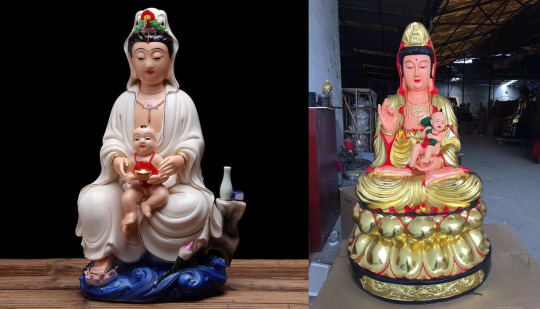

Another reason why Douma chose Guanyin might be because she’s a mother figure, the pinnacle of compassion, mercy, kindness and love, a guide for the lost souls even. Douma didn’t really have a childhood nor a proper mother figure, nobody to guide and protect him, he was always the one putting on a strong front in front of his adult followers to guide them through life and in front of his parents, so maybe he appreciates those qualities of Guanyin. It’s hard to tell if Douma is just acting or not, but for a +200 years old adult, he still acts very childish, which could be a consequence of not having the chance to act like a normal child during his childhood, so maybe he thinks he can finally have the security of childhood he didn’t have through a imaginary mother like Guanyin.
This also makes me think that Douma appreciates mothers, women with motherly traits or at least women with traits he associates with mothers. Some fans theorize that one of the reasons he fell in love with Shinobu was because she reminded him of his mother. His mother stabbed his father many times to death as revenge for his many extramarital affairs, then poisoned herself in a murder-suicide and Shinobu tries to kill him by stabbing him many times with poison, then sacrifices herself to kill him by letting him consume her because she poisoned herself with a lethal poison that kills demons to get revenge for he killing her older sister in a situation similar to a murder-suicide.
And then there’s Kotoha, the woman he chose to keep by his side until she died of old age. He said he wanted to keep her because she had a pure heart, was pretty and good at singing, but she was also a mother who went to great lengths for her baby boy, even challeging some very strict social norms for japanese women from that time by leaving her husband. Maybe deep down Douma wanted to have a mother like Kotoha. But when Kotoha found out that he was eating his followers, of course, even she cursed at him and insulted him, then ran away from him.
We don’t know if this is the only time he tried to bond with a regular human like this, but they caught him eating his followers and he sees their reactions of fear, disgust and anger, but we know how other characters react to him when they meet him and when he tries to be himself, to befriend them, to strike a conversation or to talk about himself. If Shinobu is any indicator, when he runs into a demon slayer, he’s, of course, met with deep disgust and hatred(though she particularly hated him), Kanao verbally destroyed his entire existence until she actually ticked him off because she knew his true nature and Inosuke naturally was just insulting him and cursing at him as usual.
He’s not even viewed favorably by his own demon boss and coworkers, Akaza has made it clear that he hates him, finds him annoying and too noisy(to the point he complained about him to Muzan according to the 2nd fanbook) and wants nothing to do with him, Kokushibo just ignores him so we can infer he also wants nothing to do with him, Nakime is very quick to dismiss him when he tries to invite her on a date/to go out with him so she clearly wants nothing to do with him as well as she probably knows his antics too well, his boss doesn’t like him and Hantengu doesn’t seem to want anything to do with anybody. He only seems to be on friendly terms with Gyokko.
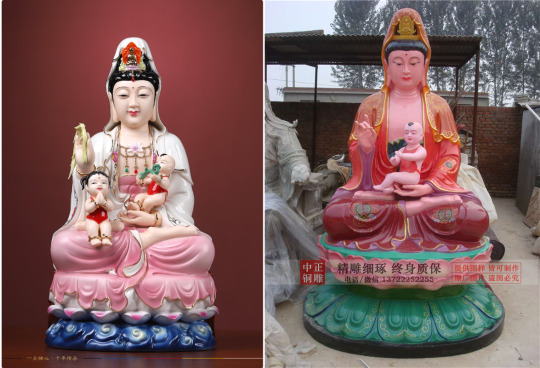
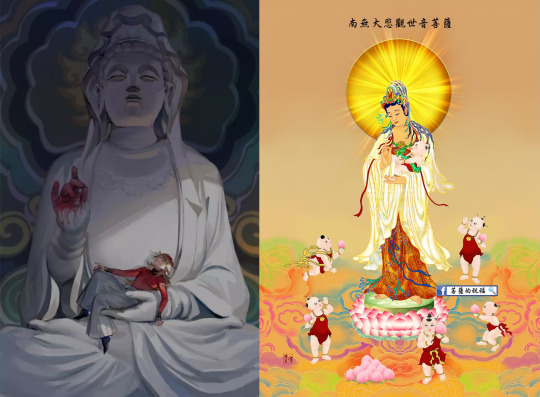
The more Douma tries to be himself around people and the more they know about him, the more they judge him, censor him, antagonize him, reject him, despise him, look down on him, fear him, ignore him, insult him, curse at him, etc. On the surfice he doesn’t seem to be very affected by it, but maybe deep down he wants someone who won’t judge him and accept him for who he is, how he thinks and what he does and maybe even someone he can drop the mask and be vulnerable with. We don’t know if Douma can make other bodhisattvas with his kekkijutsu, but the fact that he summoned Guanyin out of all of them when he needed the most, when he was about to die, might confirm that he wanted someone like that for him him since she is the perfect bodhisattva to fill that role.
In her most popular legend she used to be a princess who wanted to be a nun instead of marrying so her tyranical father tried to kill her. She miraculously survived and ran away from home. When her cruel father got sick, she gave her eye and arm to save his life. No wonder Guanyin became the bodhisattiva of mercy and compassion after that. She forgives everybody, accepts eveybody, loves everybody and doesn’t judge anyone. She’s like the perfect mother. I think it’s very easy to see why Douma would appreaciate her. She’s the buddhist counterpart to Virgin Mary and is one of the most popular and beloved figures of buddhism for a reason.
Considering all this, when Douma summoned that fake Guanyin made of ice when he was about to have his head cut feels much like a threatened child calling for their mother to protect them because they know their mother will defend them no matter what they did and that fake Guanyin feels like the mother of one of those teenagers who committed a serious crime, but she defends him anyway because she loves her son.



White Blizzard Princesses
The Three Saints of the West refer to the buddha Amitābha and the two bodhisattvas, Avalokiteśvara(Guanyin) on his right and Mahāsthāmaprāpta on his left. The main duty of the three saints is to save all sentient beings and to lead them to the Western Paradise. The buddha Amitabha is the leader of the Paradise of Bliss.
Right: Avalokitesvara Bodhisattva aka Guanyin Bodhisattva (Mandarin) 觀世音菩薩 (Japanese - Kannon Bosatsu)
Left: Mahastamaprapta Bodhisattva 大勢至菩薩 (Japanese - Seishi Bosatsu)
The depiction here of Kannon and Seishi calls to mind the Contemplation Sutra. In that sutra, the two bodhisattvas are said to have identical appearances, except for their head ornaments. Here are some passages. The complete descriptions of the bodhisattvas are worth reading.
On [Avalokiteśvara's] head, he wears a heavenly crown made of śakra-abhilagna-maṇi-gems, on which stands a transformed buddha (Amitāyus) measuring twenty-five yojanas in height.
“The heavenly crown of [Mahāsthāmaprāpta] bodhisattva is adorned with five hundred jeweled lotus flowers, each having five hundred jeweled pedestals. On each pedestal appear the pure and resplendent lands of the buddhas in the ten directions with all their boundless and glorious features.
“The mound on his head, shaped like a lotus bud, has a jeweled vase in front. This is suffused with various lights which reveal all the activities of the Buddha. The rest of the characteristics of his body are exactly the same as Avalokiteśvara’s.
“Bodhisattva Avalokiteśvara and Bodhisattva Mahāsthāmaprāpta have a similar appearance, wherever they are. Sentient beings can only tell one from the other by looking at the emblems on their heads. These two bodhisattvas assist Amitāyus in saving all beings everywhere.”
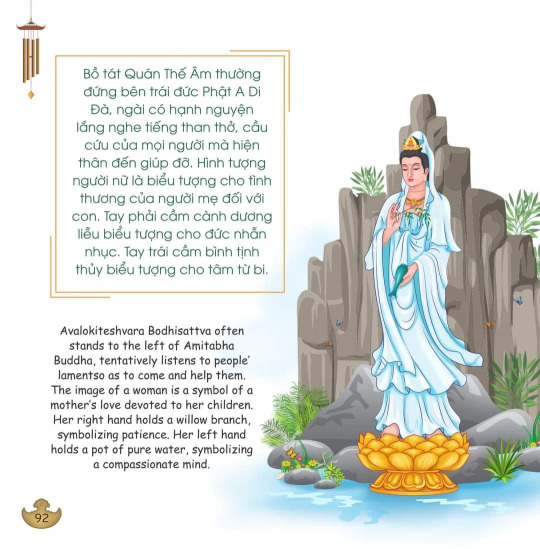

In Chinese Buddhism, Mahasthamaprapta is sometimes portrayed as a woman, Shih Chih, with a likeness similar to Avalokiteśvara. Mahāsthāmaprāpta is one of the oldest bodhisattvas and is regarded as powerful, especially in the Pure Land school, where he takes an important role in the Longer Sukhāvatīvyūha Sūtra. He is often depicted in a trinity with Amitābha and Avalokiteśvara (Guanyin), especially in Pure Land Buddhism.
In Japan Mahasthamaprapta is referred to as Seishi Bosatsu. Represents the principle of the power of wisdom. Seishi literally translates to mean, “to obtain strength.” Seishi is one of the thirteen Japanese Buddhas and is also one of the 25 Bodhisattva’s who descended from heaven with Amida to welcome dying souls into Amida’s Pure Land. Seishi is also known as one of the three sages in Pure Land Buddhism. In Pure Land Buddhism Seishi is usually depicted in a trinity with Amida and Avalokitesvara.
In this trinity Seishi is described as being one of the two attendants of Amida Buddha by representing wisdom and embodying the attributes of Amida. This is the Amida Raigo Triad and they all appear together because they are intertwined with the Buddha in the center called Amida, and on either side of him sits his Bodhisattva attendants, one being Seishi and one named Kannon. In Japan Avalokitesvara is referred to as Kannon Bosatsu( and Guanyin in China).
Seishi represents the principle of wisdom and this is conveyed symbolically in images when Seishi is depicted with a water jar in her crown. The water jar represents wisdom. Seishi is also depicted in images holding a lotus flower or with her hands held together in prayer. In the Contemplation Sutra Seishi is symbolized by the moon, as the moon represents wisdom. Seishi is portrayed in male and female form but it is most common for Seishi to be portrayed in female form.

After a brief description of the origin of the Taima-dera temple, the text introduces the pious daughter of Lord Yokohagi. She lived in the Nara period, during the life of Emperor Junnin , and later became known widely as Princess Chūjō. Various stories recorded in medieval times emphasize her unfortunate childhood, in which she was plagued by the death of her mother at a tender age, her stepmother’s demands upon her, and her father’s order of her execution, all of which led her to the path of Buddhism.
However, the text within the picture scroll does not mention any of this, but rather describes Princess Chūjō’s devout nature: She was raised deep inside the house (i.e. in a very sheltered fashion). (Her father) did not let her go outside the ornate decorated screens. In thinking of her and waiting on her as (if she were) a flawless jewel, it went even beyond (the level of thought) of the crane crying in the night (among her young ones), or the (mother) goose choked up by smoke in the (burning) fields. But, (despite her privileged upbringing, the princess’) heart was not touched by the flowers of spring, nor did she turn her thoughts to the autumn moon (i.e. she was not interested in worldly beauty). Searching deeply for the path of the Buddha, she looked for enlightenment in the Law. Accordingly, she copied one thousand sutras; she mounted them on jeweled rollers, tied them with gorgeous strings, and dedicated them to this temple.
She enthusiastically copied the Sūtra of Praising the Pure Land and made one thousand fascicle copies. This one-fascicle sūtra is a Chinese translation of the smaller Sukhāvatīvyūha sūtra by Genjō in 650 CE. Although the Sūtra of Praising the Pure Land was not as popular as the earlier translation by Kumārajīva in 402, Amitābha-sūtra, it enjoyed brief popularity in eighth century Japan when the Hossō School, founded by Genjō, established its influence in the capital. In 760, the scribes at the imperial scriptorium produced eighteen thousand copies of the Shōsan Jōdo-kyō in order to commemorate the demise of Empress Kōmyō, the empress of Emperor Shōmu.
In a chapter of the book on the praxis of Pure Land Buddhism, Hank Glassman argues that the copies for Empress Kōmyō were still circulated in the late Kamakura period and they were misidentified as Princess Chūjō’s copies intentionally by the Pure Land proselytizers to further the development of her legend. Thus according to Glassman, the copies attributed to Princess Chūjō are eighth century documents. Furthermore, the story compiled in Shijū hyaku innen-shū and many other later collections relates that the Princess served for Empress Kōken, the daughter of Empress Kōmyō, as handmaid and was appointed to the rank of middle captain from which her appellation originated. This association with the emperor seems to have made it easy to attribute the copies for Empress Kōmyō as Princess Chūjō’s. A few decades later, the Ippen Hijiri-e, the illustrated biography of Ippen, recounts Ippen’s visit to Taima-dera in Kōan.
There he was given one copy of the Sūtra of Praising the Pure Land believed to be copied and donated by Princess Chūjō. Although he treasured it tremendously because the princess was believed to be an avatar of Bodhisattva Seishi, one of Amida’s attendant, he gifted it to the monks on Mt. Shosha.
During Ippen’s confinement for prayer, the temple monks bestowed on him a priceless temple treasure, a scroll of the Sūtra in Paradise of the Pure Land. This sūtra is among a thousand scroll copies by the hand of the donor, Princess Chūjō. Since they say that this person was a manifestation of Seishi Bosatsu, Ippen regarded it as an extremely precious thing and treasured it. But at the end of his life, when he burnt his books and other things, he gave it to the monks of Shoshazan.
Although Guanyin (Avalokitesvara) is a great bodhisattva mentioned in many Buddhist sutras, the Chinese people know her primarily through her human manifestation, Princess Miaoshan (“Wondrous Goodness”). The legend of Miaoshan and its relationship with the pilgrimage center Fragrant Mountain (Xiang- shan) in Henan Province has received considerable scholarly attention.
"Kuan Yin, whose name means "one who hears the cries of the world," is perhaps the most widely revered Buddhist saint in the world. Known as Avalokiteshvara in Sanskrit, Kannon in Japanese, and Chenrezig in Tibetan, this compassionate bodhisattva is at the heart of all Mahayana Buddhist traditions. Sometimes depicted as male and other times as female, Kuan Yin took the vow to free all sentient beings from their suffering. The legend of Princess Miao-Shan is the origin story of how she became the bodhisattva known as Kuan Yin. Princess Miao-Shan lived in a country called Raised Forest around 700 B.C.E. Instead of marrying a prince according to her father's wishes, she followed her own path of spiritual practice and left the royal life behind.
Amitābha, Amida or Amideva is a celestial buddha described in the scriptures of the Mahāyāna school of Buddhism. Amitābha is the principal buddha in the Pure Land sect, a branch of Buddhism practiced mainly in East Asia, while in Vajrayana Amitābha is known for his longevity attribute, magnetising red fire element, the aggregate of discernment, pure perception and the deep awareness of uniqueness of phenomena. According to these scriptures, Amitābha possesses infinite merits resulting from good deeds over countless past lives as a bodhisattva named Dharmakāra. "Amitābha" is translatable as "Infinite Light," hence Amitābha is also called "The Buddha of Immeasurable Life and Light".
Amitabha is the Buddha of Infinite Life, and he can be recognized by the vase he holds in his lap, a symbol of longevity as it contains amrita, the nectar of immortality.
He is depicted in red color and in a meditation position, holding in his hands a vase containing amrita, the nectar of immortality that bestows longevity, and an ashoka (painkiller) tree grows from the vase.
He is mostly depicted sitting and holding in his hands a vessel containing the nectar of immortality.
According to the Larger Sūtra of Immeasurable Life, Amitābha was, in very ancient times and possibly in another system of worlds, a monk named Dharmākara. In some versions of the sūtra, Dharmākara is described as a former king who, having come into contact with Buddhist teachings through the buddha Lokeśvararāja, renounced his throne. He then resolved to become a Buddha and to create a buddhakṣetra (literally "buddha-field", often called a "Pureland" or "Buddha Land": a realm existing in the primordial universe outside of ordinary reality, produced by a buddha's merit) possessed of many perfections. These resolutions were expressed in his forty-eight vows, which set out the type of Pureland Dharmākara aspired to create, the conditions under which beings might be born into that world, and what kind of beings they would be when reborn there.
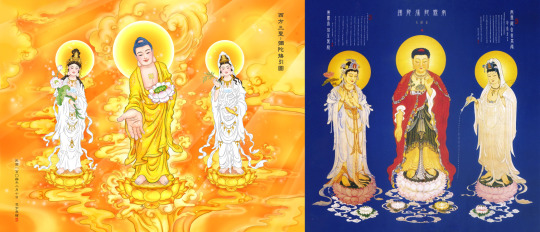
Pure Land
The main text of the Pure Land schools is the Sukhavativyuha-sutra (“Pure Land Sutra”). Written in northwestern India probably before the beginning of the 2nd century CE, the Sukhavativyuha exists in two original versions, a longer one that emphasizes good works and a shorter version that emphasizes faith and devotion alone. This sutra tells of a monk, Dharmakara, who heard the preaching of Lokeshvararaja Buddha aeons ago and asked to become a buddha. After millions of years of study, Dharmakara vowed, among other things, to establish a Pure or Happy Land, also known as the Western Paradise, if he achieved Buddhahood. In this Pure Land no evil would exist, the people would be long-lived, they would receive whatever they desired, and from there they might attain nirvana. Dharmakara then revealed in a series of 48 vows the means by which this Pure Land can be reached. Several vows emphasize meditation and good works on earth as a prerequisite, but the 18th one (a famous vow in the later development of Pure Land schools) states that, if one merely calls the name of the Buddha at the moment of death, then one will be reborn in the Pure Land.
Dharmakara, it is believed, attained Buddhahood and is known as the buddha Amitabha (Sanskrit: “Infinite Light”; Chinese: Emituofo; Japanese: Amida) or the buddha Amitayus (Sanskrit: “Infinite Lifespan”). He is flanked in the Pure Land he created in fulfillment of his vows by Avalokiteshvara (Chinese: Guanyin; Japanese: Kannon) on his left and Mahasthamaprapta on his right, who assist Amitabha in bringing the faithful to salvation.
By the 3rd century CE, the Amitabhist doctrine had spread from India to China, where a school based on it gradually became the most popular form of Buddhism. Followers of the Tendai school took Amitabhist teachings to Japan, where they attempted to weld the many sects of Buddhism into one system. By the 13th century CE, the Pure Land sect had separated from the Tendai school and spread among the common people of Japan through the work of two outstanding figures, Hōnen and Shinran.
The basic doctrines of the Pure Land schools emphasize the importance of devotion. Pure Land leaders teach that a person reaches salvation not by individual effort or the accumulation of merit but through faith in the grace of the buddha Amitabha. The main practice of those who follow the Pure Land teachings is not the study of the texts or meditation on the Buddha but rather the constant invocation of the name Amitabha, a practice based on the 18th vow of Dharmakara. Furthermore, in Pure Land Buddhism the attainment of nirvana is not the most prominent goal; it is rather to become reborn in the Pure Land of Amitabha.

Tanluan and the other 6th–7th-century Chinese Pure Land patriarchs, Daochuo and Shandao, were among those who rejected the role of works in salvation. Originally a follower of Daoism, Tanluan, while searching for the elixir of immortality, was converted to the Pure Land doctrine by an Indian monk. Dedicating his life to the spread of this doctrine, Tanluan preached the invocation of the name Amitabha and declared that even evil persons were eligible for the Pure Land if they sincerely uttered the nembutsu. He warned, however, that the lowest hell awaited those who reviled the Buddhist dharma.
Tanluan was followed by Daochuo, who argued that, because his was the age of the final decline predicted in Buddhist scriptures, people must take the “easy path” to salvation. They must trust Amitabha completely, for they are no longer able to follow the more difficult path of the saints. His disciple Shandao, believed by some Japanese Pure Land adherents to be the incarnation of Amida, shaped the doctrines of the later forms of Pure Land Buddhism. He distributed many copies of the Pure Land Sutra and wrote a commentary in which he taught that rebirth in the Western Paradise is made possible by invoking Amida. The nembutsu must be supplemented, however, by the chanting of sutras, meditation on the Buddha, worshiping of buddha images, and singing his praises.
The work of Shandao inspired Hōnen, the founder of the Pure Land sect (Jōdo-shu) in Japan, to declare that in this evil period people must put complete faith in the saving grace of Amida and constantly invoke his name. Hōnen expressed his beliefs in the treatise Senchaku hongan nembutsu-shu (1198), which was popular among the common people, as were his teachings generally. The treatise was burned by the monks of Mount Hiei, and his teachings were vigorously opposed by the established Buddhist priesthood. Indeed, opposition to Hōnen was so great that his rivals forced him into exile from 1206 to 1211.
Hōnen’s disciple Shinran, who was exiled at the same time, was the founder of True Pure Land (Jōdo Shinshu or Shin), a more radical Amida school. Shinran married with Hōnen’s consent, which thus suggests that one need not be a monk to attain the Pure Land. In Shinran’s teachings, which he popularized by preaching in Japanese villages, he rejected all sutras except the Pure Land Sutra, as well as the vows of Dharmakara in that sutra that stress individual merit. Basing his doctrines on the 18th vow, Shinran discouraged any attempt to accumulate merit, for he felt that this stood in the way of absolute faith and dependence on Amida. Furthermore, he rejected Hōnen’s practice of continual invocation of Amida, believing that the nembutsu need be said only once in order to attain salvation and that repetition of it should be regarded as praise of Amida and not as affecting one’s salvation. Thus, Shinran established the total ascendancy of the doctrine of grace. He also founded what would become the Shin school, the largest single Buddhist school in contemporary Japan. Throughout its history the Shin school has actively promoted music, dance, and drama and, since the late 19th century, has engaged in extensive educational and social welfare programs.
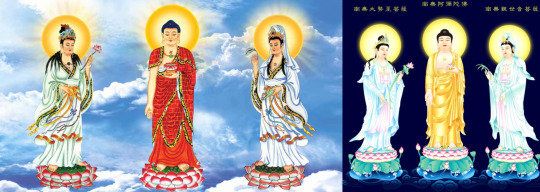
Pure Land Buddhism
Pure Land Buddhism offers a way to enlightenment for people who can't handle the subtleties of meditation, endure long rituals, or just live especially good lives.
The essential practice in Pure Land Buddhism is the chanting of the name of Amitabha Buddha with total concentration, trusting that one will be reborn in the Pure Land, a place where it is much easier for a being to work towards enlightenment.
Pure Land Buddhism adds mystical elements to the basic Buddhist teachings which make those teachings easier (and more comforting) to work with.
These elements include faith and trust and a personal relationship with Amitabha Buddha, who is regarded by Pure Land Buddhists as a sort of saviour; and belief in the Pure Land, a place which provides a stepping stone towards enlightenment and liberation.
Pure Land Buddhism is particularly popular in China and Japan.
History
Pure Land Buddhism as a school of Buddhist thinking began in India around the 2nd century BCE.
It spread to China where there was a strong cult of Amitabha by the 2nd century CE, and then spread to Japan around the 6th century CE.
Pure Land Buddhism received a major boost to its popularity in the 12th century with the simplifications made by Honen.
A century later Shinran (1173-1262), a disciple of Honen, brought a new understanding of the Pure Land ideas, and this became the foundation of the Shin (true) sect.
Pure Land Buddhism took off in Japan when the monk Honen (1133-1212) simplified the teachings and practices of the sect so that anyone could cope with them.
He eliminated the intellectual difficulties and complex meditation practices used by other schools of Buddhism.
Honen taught that rebirth in the Pure Land was certain for anyone who recited the name with complete trust and sincerity. Honen said that all that was needed was saying "Namu Amida Butsu" with a conviction that by saying it one will certainly attain birth in the Pure Land.
Honen
The result was a form of Buddhism accessible to anyone, even if they were illiterate or stupid.
Honen didn't simplify Buddhism through a patronising attitude to inferior people. He believed that most people, and he included himself, could not achieve liberation through any of their own activities. The only way to achieve buddhahood was through the help of Amitabha.
The Shin Sect
A century after Honan, one of his disciples, Shinran (1173-1262) brought a new understanding of the Pure Land ideas. Shinran taught that what truly mattered was not the chanting of the name but faith. Chanting on its own had no value at all.
Those who follow the Shin school say that liberation is the consequence of a person achieving genuine faith in Amitabha Buddha and his vow to save all beings who trusted in him.

Amitabha
Amitabha in context
The Pure Land sect emphasises the important role played in liberation by Amitabha (which means Immeasurable Light) who is also called Amitayus (which means Immeasurable Life).
People who sincerely call on Amitabha for help will be reborn in Sukhavati - The Pure Land or The Western Paradise - where there are no distractions and where they can continue to work towards liberation under the most favourable conditions.
The nature of Amitabha is not entirely clear. Encyclopedia Britannica describes him as "the great saviour deity worshiped principally by members of the Pure Land sect in Japan." Another writer says "Amitabha is neither a God who punishes and rewards, gives mercy or imposes tests, nor a divinity that we can petition or beg for special favours".
The mystical view of Amitabha regards him as an eternal Buddha, and believes that he manifested himself in human history as Gautama, or "The Buddha".
Amitabha translates as "Amito-fo" in Chinese and "Amida" in Japanese.
The story of Amitabha
Once there was a king who was so deeply moved by the suffering of beings in the world that he gave up his throne and became a monk named Dharmakara.
Dharmakara was heavily influenced by the 81st Buddha and vowed to become a Buddha himself, with the aim of creating a Buddha-land that would be free of all limitations.
He meditated at length on other Buddha-lands and set down what he learned in 48 vows. Eventually he achieved enlightenment and became Amitabha Buddha and established his Buddha-land of Sukhavati.
His most important vow was the 18th, which said:
If I were to become a Buddha, and people, hearing my Name, have faith and joy and recite it for even ten times, but are not born into my Pure Land, may I not gain enlightenment.
Since he did gain enlightenment, it follows that those who do have faith and joy and who recite his name will be born into the Pure Land.

Popularity
The sect's teachings brought it huge popularity in Japan, since here was a form of Buddhism that didn't require a person to be clever, or a monk, and that was open to the outcasts of society.
It remains a popular group in Buddhism - and the reasons that made it popular 700 years ago are exactly the same ones that make it popular today.
Understanding Pure Land
Amitabha Buddha is treated as if he were God
On the surface, yes. But perhaps chanting Amitabha Buddha's name is not praying to an external deity, but really a way of calling out one's own essential Buddha nature. However some of Shinran's writings do speak of Amitabha Buddha in language that a westerner would regard as describing God.
The Pure Land appears to be a supernatural place
On the surface, yes. But perhaps the Pure Land is really a poetic metaphor for a higher state of consciousness. Chanting the name can then be seen as a meditative practice that enables the follower to alter their state of mind. (This argument is quite hard to sustain in the face of the importance given to chanting the name in faith at the moment of death - when some supernatural event is clearly expected by most followers. And the chanting is not regarded solely as a meditative practice by most followers. However gaps between populist and sophisticated understanding of religious concepts are common in all faiths.)
There is no reliance on the self to achieve enlightenment
On the surface, yes. But in fact this is just a further move in the direction that Mahayana Buddhism has already taken to allow assistance in the journey to liberation. And the being still has much work to do when they arrive in the Pure Land. (Shinran however taught that arriving in the Pure Land was actually the final liberation - the Pure Land was nirvana.)

Buddhism and the Pure Land
Though some argue that its core beliefs and practices stand in opposition to the original teaching of the Buddha, Pure Land Buddhism is the most widely practiced sect of Buddhism in the world today. There are a number of reasons for the popularity of Pure Land Buddhism. It is possibly the most accessible form of Buddhism to the common people. The stories of the Pure Land give all those who practice and believe in the Pure Land a chance to reach enlightenment.
In Buddhism, the ultimate goal of life is to eventually reach enlightenment, or “Nirvana” as it is referred to in Buddhism. Traditionally, to attain Nirvana, followers must closely follow the teachings of the Buddha and take refuge in the Three Jewels; Buddha, the Dharma, and the Sangha.
Karma and Rebirth
In Buddhist belief, before attaining Nirvana, one must be reborn many times in order to create good karma for themselves, and eventually free themselves from karma entirely. Karma is essentially a system of cause and effect in Eastern religions. Karma determines the conditions a person will be reborn into, and a person’s current life is the direct result of their karma from previous lifetimes. If one lives a selfish or otherwise evil life, they may be reborn into one of the lower realms, such as the hell, hungry ghost, or animal realms. Living a good life allows a being to be reborn into higher realms. Eventually, through meditation and closely following the Buddha’s teachings, one can be free from the entire cycle of karma and reach Nirvana, the ultimate state of enlightenment, in which continued rebirths are unnecessary (Lopez 60).
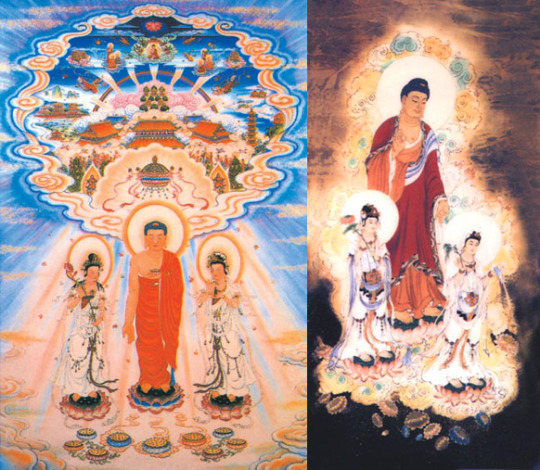
What is The Pure Land?
The Pure Land, however, is a way to escape suffering and rebirth into these lower realms before attaining Nirvana. Pure Land Buddhism is considered a branch of Mahayana Buddhism, but has some different beliefs than traditional Buddhism. In Pure Land Buddhism, one must only speak the name of Amitabha Buddha to be reborn into the Pure Land upon death. Amitabha Buddha, according to Pure Land beliefs, vowed to save all sentient beings who called upon his name. When someone calls upon Amitabha Buddha, they are able to be reborn into the Pure Land, where enlightenment can be obtained much more easily than on Earth. One needs not even seek guidance from a teacher in this tradition, as all guidance is received from Amitabha Buddha. It isn’t necessary to meditate or even to closely follow the Buddha’s teachings to be allowed to enter the Pure Land (Gach 219-221).
The Pure Land vs. Heaven
It isn’t difficult to draw parallels between the idea of the Pure Land and certain Christian beliefs. The idea of being able to be reborn into the Pure Land just by speaking Amitabha Buddha’s name is very similar to the idea of being forgiven for one’s sins and being able to go to Heaven just by accepting Jesus as the savior. In both of these belief systems, even the most evil people can have a second chance in the afterlife just by turning to the divinity figure of their religion (Leeming 69-72).

Why is Belief in the Pure Land so Important?
Because the Pure Land is so easy to reach, the goal of enlightenment, or Nirvana, is made much more attainable for followers of Pure Land Buddhism. The Pure Land welcomes “rich and poor, man and woman, old and young” (Gach 220). This is significant because it makes Buddhism, and the Buddha’s teachings, much more accessible to the common man. Because Nirvana was considered a difficult goal, especially for laypeople (people who are not monks or nuns), “various alternatives to it have been set forth, none perhaps more famous than the so-called ‘pure land’” (Lopez 60). The idea of the Pure Land was put forth to give followers an easier way to attain enlightenment, since a life of strict adherence to the Buddha’s teachings and meditation would not be realistic for common people trying to practice Buddhism.
The idea of rebirth into the Pure Land also gives great amounts of comfort to the dying, and the family members of the dying. Reciting the name of Amitabha Buddha “is a central element of death rituals” (Lopez 61). This “offers deathbed reassurance of a blessed afterlife” (Gach 220). Beings who are reborn into the Pure Land “suffer no bodily pain and no mental pain, rather they gain measureless causes for happiness” (Lopez 62). You can see how this idea of the Pure Land has gained popularity throughout Buddhist cultures as a means for helping followers to deal with death.
In Conclusion
The idea of the Pure Land in some Buddhist traditions has become a powerful myth. The possibility of being reborn into the Pure Land gives hope for attaining Nirvana to Buddhists who may not be able to follow the path set forth by the Buddha in this lifetime. Even people who have made many mistakes throughout their lifetime can escape the fate created by the negative karma they have accumulated and have a blissful afterlife.
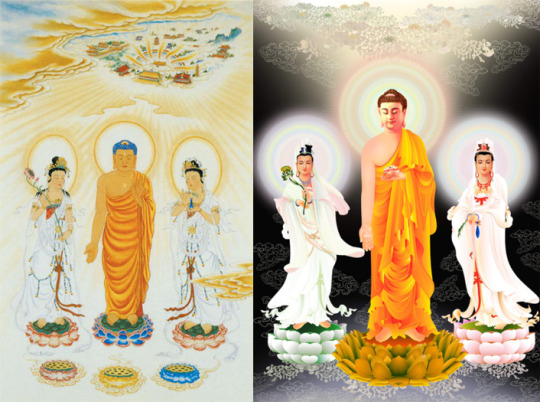
The Potential of Propagating Pure Land Buddhism in the West
Pure Land Buddhism at a glance
Among the many different schools of Chinese Buddhism—such as Chan (Zen in Japanese), Tientai, Huayen, and Fashiang—Pure Land arguably has the largest following. While its doctrinal development took place in China, Pure Land is the major school of Buddhism in Hong Kong, Japan, Taiwan, Vietnam, and other Asian countries.
The main reason for this popularity is that Pure Land Buddhism is characterized by its “easy practice:” the repetition of Amitabha Buddha’s sacred name (Na-Mo-A-Mi-Tuo-Fo) by adherents in their daily lives. While almost all Chinese Buddhists know how to recite Namo Amituofo in a temple, at home, or under any other circumstances, it does not mean that they are necessarily followers of Pure Land Buddhism, yet it does show how deeply Pure Land practice has penetrated the Chinese consciousness.
Na-Mo-A-Mi-Tuo-Fo is the name of the Buddha of infinite light and life, Amitabha. In Pure Land Buddhism, devoted recitation of Amitabha’s name is believed to be the quickest way for monastics and lay people to gain postmortem entry (rebirth) into the blissful realm known as the Pure Land—the home of Amitabha Buddha.
Pure Land adherents joyfully and sincerely entrust themselves to Amitabha’s deliverance, thus “faith by devotion” is the first step necessary for gaining rebirth in Amitabha’s Land of Bliss. All the inhabitants of the Pure Land are Amitabha’s dependents, and are also students, and enjoy almost the same wisdom and power as Amitabha Buddha. They are also assured of attaining enlightenment and Buddhahood. At first glance, this teaching seems similar to the Christian concept of salvation through Jesus Christ.

An independent school, or affiliated with other schools?
A temple of any Buddhist school (such as Chan) that includes Amitabha-recitation in its ritual or daily practice is said to propagate Pure Land Buddhism. Likewise, a layperson or monastic who recites Namo Amituofo for any reason may think that he is practicing Pure Land Buddhism. Is it really that simple? Can Pure Land teachings be practiced in affiliation with other schools of Buddhism?
As Pure Land self-identifies as a school of Buddhism, it follows that it must have its own complete and independent system of teachings. It must also be able to distinguish itself from other systems, both Buddhist and non-Buddhist. For instance, the Land of Bliss is not an ordinary pure land, or a mere heavenly realm, as many people think.
That said, there is also much overlap between Pure Land and other Buddhist schools. In any Mahayana school, bodhisattvas are required to make vows in their causal grounds and set forth their Bodhi Mind to deliver sentient beings of the Ten Directions. They must actively pursue wisdom for long periods of time to realize the ultimate truth. Moreover, they must achieve and accumulate immeasurable merit and virtue through myriad self-powered practices. In this way, they can deliver sentient beings of the Ten Directions before attaining Perfect Enlightenment and achieving Buddhahood.
However, the Pure Land teachings seem to set forth a different narrative. A Pure Land practitioner is a “receiver” of merit, rather than a “donor” of merit, according to the bodhisattva teachings. He is a recipient of infinite merit and virtue, dedicated by Amitabha Buddha to all those who practice the exclusive recitation of his sacred name. This is why Pure Land asserts itself as an independent school. Other schools use Amitabha’s name as a means to generate merit towards rebirth in the Pure Land. The Pure Land school teaches “faith by devotion” and receiving Amitabha’s merit and virtue through the exclusive recitation of his name. In this way, Pure Land adherents are reborn in the Land of Bliss naturally and effortlessly.
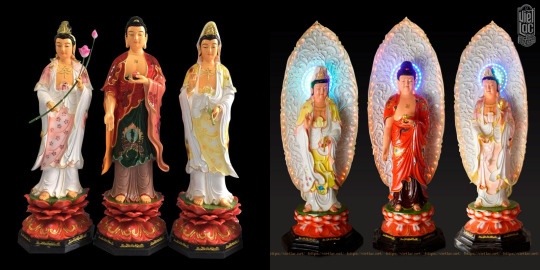
The two streams
Obviously, Pure Land stands in sharp contrast to other schools of Mahayana Buddhism, which focus almost entirely on meditation as a means to calm and purify the mind. However, these two Buddhist streams—Pure Land Buddhism and “conventional” Buddhism—are not necessarily antagonistic. Together, they fully elucidate the bodhisattva career, one focusing on the donor of merit, and the other on the receiver of merit.
In the West, Pure Land Buddhism is quietly but diligently practiced in communities of Asian immigrants, most of whom do not speak English. They generally meet in palace-like temples in most large cities of Europe and North America, and often escape the notice of mainstream Western Buddhists, who tend to think of Pure Land as “ethnic” Buddhism restricted to a particular group of Asian people. However, some scholars of religion are increasingly emphasizing that Pure Land is one of two distinct but important Buddhist streams in Western countries.
Considering that both Pure Land Buddhism and Christianity emphasize faith by devotion, there is a great deal of potential for propagating Pure Land in the West. Unfortunately, because of a relative lack of English-language material, Pure Land Buddhism remains unfamiliar to many Westerners and is currently less popular than Theravada, Vajrayana, or Zen Buddhism. When more English information is published and transmitted through social media, Pure Land Buddhism will likely grow in popularity. Westerners are hungry for religion that can be practiced by ordinary people in the midst of ordinary life, and the Pure Land path was taught specifically for this reason.
Moreover, Pure Land Buddhism provides a choice for other Buddhists who practice the meditative virtues. Should they grow discouraged at the prospect of practicing for many years to attain enlightenment, they may consider switching to Pure Land Buddhism. Through Amitabha-recitation, they can put faith faith in Amitabha’s deliverance and attain rebirth in the Land of Bliss, where conditions for practice are so optimal that Enlightenment naturally unfolds.

When Mahayana Buddhism arrived in Japan in the sixth century CE, the archipelago already had a native religion, Shinto, and the relationship between the two has been alternatively harmonious and fraught ever since, depending on many things, especially politics. Buddhism had a particularly hard time of it as recently only 150 years ago, during the Meiji Restoration, when the restoration of the Imperial family to power led many (including the Emperor Meiji) to denounce Buddhism.
But Buddhism has survived in its several forms, less the result of splits as of refinements. The two forms that came intact from China, and remain the forms one is most likely to encounter in Japan, are Pure Land Buddhism and Zen Buddhism. (To make things even more confusing, Pure Land Buddhism has itself split into two forms, Orothodox and Shin (True) Pure Land Buddhism. But for clarity’s sake, we’ll stay with general descriptions of the two main schools.)
The basis of Pure Land Buddhism is devotion. In this way, it is the more traditionally religious expression of the teachings of the Buddha, who did not talk about gods or promise heaven (or hell). Buddha was, if anything, a philosopher who had found a secret to understanding life; he never claimed divinity. But Pure Land Buddhism would sound somewhat familiar to devotees of Islam and Christianity: the basic idea is to show one’s devotion to what has been named Amida Buddha, the Celestial Buddha. (This Buddha is said to actually be based on an entirely different historical person, a monk called Dharmakāra, rather than the traditional Buddha, who was a prince known as Siddhartha.) Through devotion – prayer, chanting Amida Buddha’s name and other acts of devotion, one is assured one’s place in the Pure Land, or Western Heaven or, as Westerners of any religious stripe would call it: Heaven.
In Pure Land, moreover, one’s own work and deeds have no impact on one’s salvation. All that matters in one’s devotion to Amida Buddha. Thus, in Pure Land, which was brought to Japan by a man named Honen in the 12th Century CE, the way to salvation (heaven) was not through philosophy or meditation, but by “behaving themselves like simple-minded folk.” Likewise, the only practice required of Pure Land devotees is the recitation of the words “Namu Amida Butsu (homage to Amida Buddha).” Any other practice is seen as a sign of a lack of devotion to the Amida Buddha.

According to the scriptures of Pure Land Buddhism, the Land of Ultimate Bliss is situated in the western part of the cosmos. Why? It provides a clear destination that reassures the mortals’ faith of rebirth in that land, and after rebirth, we will attain perfect enlightenment, and our dharma body will permeate the worlds of the ten directions.
In The Infinite Life Sutra, Sakyamuni Buddha employed the Venerable Ananda as the target opportunity to introduce Amitabha Buddha’s Forty-eight Great Vows, which he accomplished by practicing the virtuous way of Bodhisattva over immeasurable kalpas. Amitabha’s great vows are for the benefit of all sentient beings. His Land of Ultimate Bliss is also for the benefit of all sentient beings, and his innumerous virtues and merits accumulated over the immeasurable ages are also for all of us mortals. Since all his great vows and all his virtuous practices are for us, and since he has attained Buddhahood, isn’t it true that we all may soon become Buddhas?
After Sakyamuni Buddha’s explanation, Ananda asked the Buddha: “Has Dharmakara Bodhisattva attained Buddhahood as a Buddha of the past, or has he not? Where is he now?” Ananda asked about Amitabha Buddha of the three ages: the past, present, and future: Has Dharmakara Bodhisattva been a Buddha of the past, or is he not a Buddha yet? If he is a Buddha in the present, where is he now preaching the Dharma and delivering sentient beings?
Why does Venerable Ananda ask this question? In what kind of mood? In these few verses, it is evident that Ananda is anxious to know about Amitabha Buddha. Why? Because Ananda has realized that there is Amitabha Buddha who delivers sentient beings, and there is the Land of Ultimate Bliss for sentient beings. He wants to know right away if Dharmakara Bodhisattva has become Amitabha Buddha; if he had and already passed away, we would have missed the rare opportunity to be free of samsara and attain Buddhahood. So, his first question is whether Amitabha Buddha was a Buddha long passed away.
His second question is if Dharmakara Bodhisattva has not attained Buddhahood, how long do we have to wait for him to do so?
Ananda’s third question is if he is a Buddha in the present, where is he now?
Then, the Buddha replies, “Dharmakara Bodhisattva is now a Buddha residing in the far west, as many as ten trillion Buddha-lands away, in the land called Peace and Bliss.”
In response to Venerable Ananda’s question, the Buddha replied that Dharmakara Bodhisattva has now become a Buddha, and resides in the West, some ten trillion Buddha-lands away, in a world called Peace and Bliss.
There are several names for that land. It is called the Land of Ultimate Bliss in Amitabha Sutra, as in The Contemplation of Infinite Life Sutra. The Infinite Life Sutra also calls it the Land of Peace and Joy and the Land of Peaceful Home. In the Treatise and Gatha on Rebirth in the Sutra of the Infinite Life by Vasubandhu Bodhisattva (⁓ 4th century), it is called Lotus Treasury World. These different names mean the same.
The Amitabha Sutra says the Land of Ultimate Bliss is in the west, and so does The Infinite Life Sutra. The Amitabha Sutra reads: “At that time, the Buddha told the elder Sariputra, ‘In the far west, beyond as many as ten trillion Buddha-lands away, there is a world called Ultimate Bliss, and in that land, there is a Buddha named Amitabha, who is even there expounding the Dharma.’”
Whether it is The Amitabha Sutra or The Infinite Life Sutra, they both tell us that the Land of Ultimate Bliss is in the West. So, why should we discuss the theme of Where the Land of Ultimate Bliss is? This is because the scriptures also say that the Land of Ultimate Bliss is “vast and incomparable, extensive, and limitless, and supremely wonderful”. The meaning of it is that the Land of Ultimate Bliss is so huge that it has no boundary and permeates the entire cosmos.

Sukhavati
Sukhavati, (Sanskrit: literally “Land of Bliss” or “Pure Land of Bliss”; often translated as “Pure Land”) in the Pure Land schools of Mahayana Buddhism, the Western Paradise of the Buddha Amitabha, described in the Pure Land sutras (Sukhavati-vyuha-sutras). According to followers of the Pure Land schools, which are widespread throughout East Asia, rebirth in Sukhavati is ensured by invoking the name of Amitabha, particularly at the moment of death.
According to the “larger” of the Pure Land sutras, only men may be reborn in Sukhavati; this teaching was repeated and adapted by some Buddhist groups as Pure Land teachings spread from India into East Asia. However, some vernacular Buddhist writings, particularly in East Asia, demonstrate a popular belief that women may also enter Sukhavati upon death.
Sukhavati is expressively described in the Pure Land sutras as being a joyous world, soft and glowing, filled with the music of birds and the tinkling of trees adorned with precious jewels and garlands of golden bells. Amitabha sits on a lotus in the midst of a terraced pond, attended by the bodhisattvas (“buddhas-to-be”) Avalokiteshvara and Mahasthamaprapta. The newly dead enter into lotus buds, which unfold when the occupants have become entirely purified and have attained enlightenment. Many are said to be reborn on Earth after leaving Sukhavati to become bodhisattvas working toward the liberation (moksha) of all sentient beings.

While I was doing my research, I noticed that the word “bliss” appeared very often with terms like Land of Bliss, Blissful Abode, Land of Ultimate Bliss, Pure Land of Bliss, Land of Pure Bliss, Realm of Bliss, Paradise of Bliss, etc. This reminded me that Douma had the word “bliss” written on hanging flags in the room where he receives his followers. Wondering if that was just a coincidence or not, I searched for the original japanese version of this panel to check if the kanji for this “bliss” and the kanji for “Land of Bliss” were the same or similar. To my utter surprise, the kanji were the exact same for both:

The japanese version of the wikipedia:

The Jisho dictionary and other dictionaries:


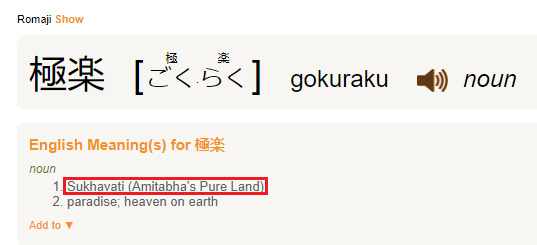
I was already thinking that Pure Land Buddhism and Douma’s Eternal Paradise Faith were identical and that there were obvious influences, but now I have concrete proof. Gotouge straight up wrote 極楽(gokuraku), which means Sukhavati, the name of Amitabha’s Pure Land four times in the room where Douma receives his followers! I don’t think they could have been more direct than that. By the way, 極楽(gokuraku) is even the name of a J-Pop song from 2016:

Unfortunately, the video clip doesn’t seems to have anything to do with Pure Land Buddhism, but I don’t know about the lyrics though. By the way, “Amida” is Amitabha’s japanese name. Anyway, I’ve always found it weird how Douma always talks about some paradise and how his followers blindly worships him as of he was a savior, even asking him to guide him to this paradise because his kekkijutsu is obviously influenced by buddhism, but that was not how I pictured buddhism at all. First, I always thought that there was no Heaven and Hell or Gods in buddhism. Second, I also thought buddhism was all about “going on a self-discovery journey” in search for enlightenment.
Because of these ignorant preconceptions of buddhism of mine, I always thought this whole messianic character and blind devotion to a religious leader didn’t belong in buddhism. Douma seemed like he was impersonating Jesus Chist way more. But after I searched about the topic, everything is so clear now. There’s not just one type of buddhism, but many types of buddhism.
Two major extant branches of Buddhism are generally recognized by scholars: Theravāda (Pali: "The School of the Elders") and Mahāyāna (Sanskrit: "The Great Vehicle"). Theravada has a widespread following in Sri Lanka and Southeast Asia such as Cambodia, Laos, Myanmar and Thailand. Mahayana, which includes the traditions of Zen, Pure Land, Nichiren Buddhism, Tiantai Buddhism (Tendai), and Shingon, is practiced prominently in Nepal, Malaysia, Bhutan, China, Japan, Korea, Vietnam, and Taiwan.
"Mahāyāna" also refers to the path of the bodhisattva striving to become a fully awakened Buddha (samyaksaṃbuddha) for the benefit of all sentient beings, and is thus also called the "Bodhisattva Vehicle" (Bodhisattvayāna). Mahāyāna also includes numerous Buddhas and bodhisattvas that are not found in Theravada (such as Amitābha and Vairocana).Mahāyāna Buddhist philosophy also promotes unique theories, such as the Madhyamaka theory of emptiness (śūnyatā), the Vijñānavāda doctrine and the Buddha-nature teaching.

Śūnyatā
Śūnyatā, शून्यता (Sanskrit meaning "Emptiness" or "Voidness"), is an important Buddhist teaching which claims that nothing possesses essential, enduring identity because everything is interconnected in a chain of co-becoming and in a state of constant flux. In various schools of Buddhism, Śūnyatā is a key concept used to express that everything one encounters in life is empty of absolute identity, permanence, or an in-dwelling 'self' because everything is inter-related and mutually dependent—never wholly self-sufficient or independent. The importance of this insight is especially emphasized in Mahayana Buddhism.
Widely misconceived as a doctrine of nihilism, the teaching on the emptiness of persons and phenomena is unique to Buddhism, constituting an important metaphysical critique of theism with profound implications for epistemology and phenomenology. In the English language, the word emptiness suggests the absence of spiritual meaning or a personal feeling of alienation, but in Buddhism the realization of the emptiness of phenomena enables liberation from the limitations of form in the cycle of uncontrolled rebirth.
Description
The theme of śūnyatā emerged from the Buddhist doctrines of Anatta (nonexistence of the self) and Pratitya-samutpada (Interdependent Arising). The Suñña Sutta, part of the Pali Canon, relates that the monk Ananda, the attendant to Gautama Buddha asked, "It is said that the world is empty, the world is empty, lord. In what respect is it said that the world is empty?" The Buddha replied, "Insofar as it is empty of a self or of anything pertaining to a self: Thus it is said, Ananda, that the world is empty."
According to the 14th Dalai Lama:
"One of the most important philosophical insights in Buddhism comes from what is known as the theory of emptiness. At its heart is the deep recognition that there is a fundamental disparity between the way we perceive the world, including our own experience in it, and the way things actually are. In our day-to-day experience, we tend to relate to the world and to ourselves as if these entities possessed self-enclosed, definable, discrete and enduring reality. For instance, if we examine our own conception of selfhood, we will find that we tend to believe in the presence of an essential core to our being, which characterises our individuality and identity as a discrete ego, independent of the physical and mental elements that constitute our existence. The philosophy of emptiness reveals that this is not only a fundamental error but also the basis for attachment, clinging and the development of our numerous prejudices. According to the theory of emptiness, any belief in an objective reality grounded in the assumption of intrinsic, independent existence is simply untenable. All things and events, whether ‘material’, mental or even abstract concepts like time, are devoid of objective, independent existence."
According to Thanissaro Bhikku:
Emptiness as a quality of dharmas, in the early canons, means simply that one cannot identify them as one's own self or having anything pertaining to one's own self...Emptiness as a mental state, in the early canons, means a mode of perception in which one neither adds anything to nor takes anything away from what is present, noting simply, "There is this." This mode is achieved through a process of intense concentration, coupled with the insight that notes more and more subtle levels of the presence and absence of disturbance (see MN 121).
From the Heart Sutra:
“Form is emptiness; emptiness also is form. Emptiness is no other than form; form is no other than emptiness. In the same way, feeling, perception, formation, and consciousness are emptiness.”
The view of “emptiness” (Sanskrit: śūnyatā) is at the core of Buddhism. The Sanskrit term is composed of the word śūnya, plus -tā (“ness”); śūnya meaning “zero,” “nothing,” “empty” or “void,” its root being śvi, or “hollow.” The principle of sunyata posits that all phenomena, including the “self,” are empty of “own-being” (Sanskrit: svabhāva), or an intrinsic essence or nature.
The Buddha taught that there are five aggregates (Sanskrit: skandhas) that collectively constitute a human individual:
Form (Sanskrit: rūpa)
Sensations (Sanskrit: vedanā)
Perceptions (Sanskrit: saṃjñā)
Mental formations (Sanskrit: saṃskāra)
Consciousness (Sanskrit: vijñāna)
While their nature is essentially “empty,” due to our ignorance and inability to realize the ultimate truth of “non-existence of self” (Sanskrit: anātman), these bodily and mental factors are subject to grasping and craving, and lead to suffering (as taught in the Four Noble Truths).
Emptiness encompasses the process of Dependent Origination (Sanskrit: pratītyasamutpāda), namely that all phenomena arise interdependently based on a convergence of causes and conditions.

The Prajñāpāramitā (Perfection of Wisdom) Sutras taught that all entities, including dharmas, are empty of self, essential core, or intrinsic nature (svabhava), being only conceptual existents or constructs. The notion of prajña (wisdom, knowledge) presented in these sutras is a deep non-conceptual understanding of emptiness.The Prajñāpāramitā sutras also use various metaphors to explain the nature of things as emptiness, stating that things are like "illusions" (māyā) and "dreams" (svapna). The Astasahasrika Prajñaparamita, possibly the earliest of these sutras, states:
If he knows the five aggregates as like an illusion, But makes not illusion one thing, and the aggregates another; If, freed from the notion of multiple things, he courses in peace— Then that is his practice of wisdom, the highest perfection.
Perceiving dharmas and beings like an illusion (māyādharmatām) is termed the "great armor" (mahāsaṃnaha) of the Bodhisattva, who is also termed the 'illusory man' (māyāpuruṣa). The Vajracchedikā Prajñāpāramitā Sūtra adds the following similes to describe how all conditioned things are to be contemplated: like a bubble, a shadow, like dew or a flash of lightning. In the worldview of these sutras, though we perceive a world of concrete and discrete objects, these objects are "empty" of the identity imputed by their designated labels. In that sense, they are deceptive and like an illusion. The Perfection of Wisdom texts constantly repeat that nothing can be found to ultimately exist in some fundamental way. This applies even to the highest Buddhist concepts (bodhisattvas, bodhicitta, and even prajña itself). Even nirvana itself is said to be empty and like a dream or magical illusion. In a famous passage, the Heart sutra, a later but influential Prajñāpāramitā text, directly states that the five skandhas (along with the five senses, the mind, and the four noble truths) are said to be "empty" (sunya):
Form is emptiness, emptiness is form
Emptiness is not separate from form, form is not separate from emptiness
Whatever is form is emptiness, whatever is emptiness is form.




The similarities between Douma’s Paradise Faith and Pure Land Buddhism are endless, it’s almost as if he plagiarized the latter. If his followers prostrating themselves before him and begging him to guide him to paradise isn’t enough to convince you, he complains about his followers being stupid and says that killing and eating them is alleviating their suffering and guiding them to enlightenment. According to the articles from my research, Pure Land Buddhism is a simplified form of buddhism for “stupid”, illiterate and simpleminded folk, many times suffering from poverty and natural disasters.
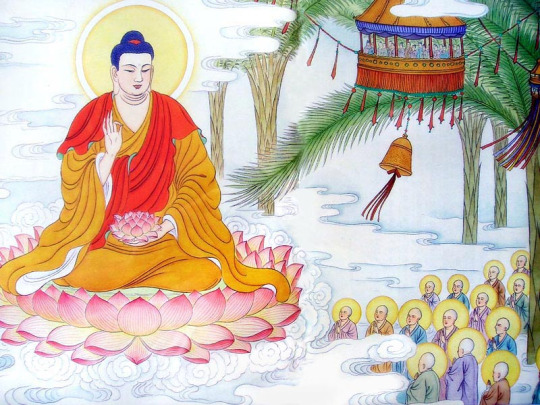
Amitabha said he wants to free people from suffering and and guide them to enlightenment and he wants to do that by sharing his accomplishes with his worshipers once they're born in his Western Paradise or Pure Land. This feels like he's merging with his worshipers, much like when Douma eats or ansorbs his followers. Next you will see correlations between Douma manga panels with various bits of articles from my research about Amitabha trying to prove the conection. You can skip this part if you want.
The Buddha is Amitabha, the Buddha of Infinite Light. He resides in his heavenly realm called the Western Paradise, or Pure Land. Devotees believe that absolute faith in Amitabha empowers a person to be reborn in his paradise. According to the scriptures, the Western Paradise is a land of bliss.
Pure Land Buddhism speaks not the mysterious and the subtle but rather illustrates the doctrines from facts; as long as you recite Amitabha Buddha, you will be born in the Land of Ultimate Bliss. It is because Amitabha, before he became Buddha, has made the vows for us, cultivated the virtues and merits for us, and built a land of peace and bliss for us. Now he is Buddha, in all time and everywhere in the universe. If we recite his name, Amitabha Buddha will hear us; if we worship him, Amitabha Buddha will see us; if we think about him, Amitabha Buddha will know. He blesses us and turns ill events to auspicious ones, bad luck to good fortune, crisis to manageable events. When facing death, Amitabha Buddha will hear our prayers, relieve our suffering, and come to lead us to his Land of Ultimate Bliss. The doctrine of Pure Land Buddhism is simple; its straightforward facts manifest its profound truth.
The Amitabha faith gained popularity in the Heian era. Followers of this faith leave themselves in the hands of the Buddha Amitabha in hopes of entering the pure land upon death. Life in the pure land is without worry or care and if you pray “Hail Amitabha Buddha” everyday, in the afterlife Amitabha himself will lead you to the holy land.
Although Amitabha, the great Buddhist god of mercy and sympathy, is called ‘sovereign teacher of the Western heaven’, he is better known as the ‘guide to the West’. In Buddhism, devotees believe that if they chant the Amitabha canons dutifully in their lifetime, their souls will be led to the Western Paradise by Amitabha at their hour of death.
It is as if Amitabha is always reaching out to us with a perfectly steady hand. But our hand, moving erratically all the time, a symbol of our thoughts jumping from one thing to another, must first be stilled before we can take his. By single-mindedly repeating Amitabha’s name as we are breathing our last breaths, our finally still mind will resonate with his and we will be as one. He will come, just as he vowed, to guide us to his land of Ultimate Bliss.
A Case Example
Shining (his dharma name), an elderly Chinese man living in Hong Kong, was a non-smoker and non-alcohol user. Having been a committed Buddhist since 1988, he began to be a vegetarian in 2006. After his retirement in 2004, he was a full-time volunteer worker in temples and was extremely welcome among his Buddhist companions due to his hard-working, generosity, helpfulness, kindness, and tenderness.
Shining was diagnosed with advanced prostate cancer with bony metastasis in the pelvis in early 2015 and underwent an orchidectomy in late February. He continued to visit his doctor regularly, and no drugs were adopted. Believing that death is the part of life where life and death form a two-sided coin, he lived with cancer without death anxiety and did not expect a miracle to cure the illness. As a devotee of the Pure Land School, he sincerely expected the Buddha Amitābha to guide him to the Pure Land, that brightest, most eased, tranquil, and purified resort, following his death.
Unfortunately, he relapsed into carcinoma and suffered from cancer-induced bone pain in his left leg in mid-October. Having taken one bicalutamide tablet (50 mg) daily and in spite of taking pain-relieving drugs in mid-November, his pain grew and painkillers made his stomach uncomfortable, which destroyed his appetite and caused him to lose weight drastically. He ceased using pain-relieving drugs for an additional reason: there is a conflict between the unconscious drowsiness brought on painkillers and the maintenance of a high level of consciousness. Buddhist end-of-life patients strive to retain consciousness so as to follow the Buddha Amitābha to the Pure Land.
Subsequently, he underwent an inpatient course of radiotherapy (five times) from December 1 in order to reduce the pain, but found no improvement. He stayed in hospital for supplementary treatments such as physiotherapy until his unexpected but peaceful passing away on December 20, due to the failure of an emergency operation for a non-cancer cause. Shining carried out a series of assignments for about half an hour every morning, including chanting and reciting Buddhist scriptures, incanting, burning incense, and kneeling to worship buddhas and bodhisattvas.
“With my divine power I will display great light,
Illuminating the worlds without limit,
And dispel the darkness of the three defilements;
Thus I will deliver all beings from misery.”

The Pure Land Study is a method of cultivation introduced and taught by Shakyamuni Buddha twenty-five hundred years ago for people who wish to attain Buddhahood within one lifetime. It is the fastest and easiest way for anyone who wishes to transform this life's pain, suffering, misery and misfortune into a life of happiness, fulfillment and prosperity with direction and purpose.
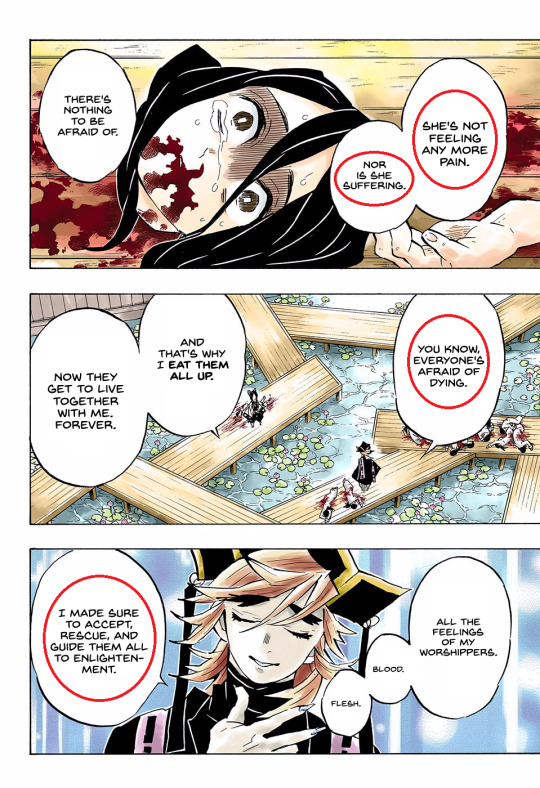
“This practice is for healing the mind, also overcoming fear of dying, also overcoming fear of what happens after death, or in other words after I’m gone from this world, what happens. Right? There’s big question mark for most people, I would say.”
When the Amitabha Faith came into popularity, the country was surrounded by violence. Due to a disparate difference in class at the time, many people were forced to live on the streets. The sides of major roads and the Kamo River were lined with bodies of those who lost their lives to famine and disease. In a world with nothing but suffering and hardship, the Amitabha faith offered the hope that at least in the afterlife they could be saved.
Throughout history, people of all cultures have asked the existential question, “Where do we go after we die?” A popular Buddhistic response to this question in medieval Japan was the western Pure Land (J. saihō jōdo) of the Buddha Amitabha (J. Amida). The idea of being born in a resplendent, distant paradise and envisioning departed loved ones there gave hope and solace to many facing the fear of death. These sentiments contributed to the popularity of Pure Land beliefs and resulted in the production of numerous raigō zu (“welcoming approach” paintings), in which Amitabha Buddha attended by a multitude of bodhisattvas appears before devotees at the time of their death, and jōdo zu (Pure Land paintings), which depict scenes of Amitabha’s paradise that awaits devotees after death.
The idea of rebirth into the Pure Land also gives great amounts of comfort to the dying, and the family members of the dying. Reciting the name of Amitabha Buddha “is a central element of death rituals” (Lopez 61). This “offers deathbed reassurance of a blessed afterlife” (Gach 220). Beings who are reborn into the Pure Land “suffer no bodily pain and no mental pain, rather they gain measureless causes for happiness” (Lopez 62). You can see how this idea of the Pure Land has gained popularity throughout Buddhist cultures as a means for helping followers to deal with death.
Amitabha as a savior figure and the fear of death
As a Buddhist who believes in the Pure Land teachings and trusts in the power of Amitabha to bring us to the pure land after death together with our own power of belief and devotion, genuine aspiration for enlightenment, I've found the Pure Land teachings to be very reassuring and calming to me. Whenever I hear about the next supposedly world ending event in the news, I remind myself that everything is impermanent, and should i die in one of these catastrophes or just die in general I can trust in the soteirological power of Amitabha to bring me to the pure land, and so dispel many of my worries and fears about death.
While I certainly do NOT want to die, and would be pretty damn pissed if I did die soon, this practice has helped me with my anxiety about death and reinforced my trust and faith in Amitabha. I wonder if anyone else has done this practice of recalling Amida Buddha's power and compassion when afraid of death, and if anyone else follows Amitabha as a savior figure, who will rescue from this cycle of death and rebirth and bring to his pure land any who accept him into their hearts and genuinely desire enlightenment? I find him a powerful and merciful savior figure and one of the three Bodhisattvas I venerate the most alongside Avalokiteshvara and Tara.
One of the answers:
I've never been afraid of death -- you might call me an annihilationist, since I came into the practice afraid of rebirth and the idea that if I didn't follow the path, I'd have to endure childhood again (which was not pleasant). But I also doubted Amitabha immensely, since I was raised in the Pure Land teachings and my parents weren't capable of answering any of my endless questions, I started to see Pure Land Buddhism as similar to the American Protestantism I was surrounded by: faith-based drivel.
The nature of Amitabha is not entirely clear. Encyclopedia Britannica describes him as "the great saviour deity worshiped principally by members of the Pure Land sect in Japan."
There was a belief that the world had degenerated to a point where humanity could no longer be delivered by its own effort and must rely on faith and on devotion to a powerful savior in order to be released from sin and suffering.
All-knowing and boundless, Amitabha is often regarded as the most powerful Buddha representing immeasurable light and life. Symbolising compassion, wisdom and kindness, Amitabha devotes his life to the enlightenment of all sentient beings, making it his mission to illuminate their paths of growth, success and prosperity.
Amitābha is the buddha of comprehensive love. He lives in the West (represented as a meditating Buddha) and works for the enlightenment of all beings (represented as a blessing Buddha). His most important enlightenment technique is the visualization of the surrounding world as a paradise. Those who see his world as a paradise awaken his enlightenment energy. The world can be seen as a paradise by a corresponding positive thought (enlightenment thought) or by sending light to all beings (wish all beings to be happy).
Pure Land Buddhists believe they will achieve enlightenment and Buddhahood through their faith in Amitabha Buddha and by reciting Amitabha’s name and vows.
“I dedicate this merit to all sentient beings
In order that they may attain full awakening
Through the merit of these acts,
May I quickly realise the state of Buddhahood
And having done so,
May I help all beings without exception
To reach that profound state.”

Amida Buddha built his Pure Land for the salvation of all human beings, with absolutely no discrimination against anyone. In this context salvation means birth in the Pure Land, the attainment of Enlightenment. When they enter the Pure Land, people become enlightened through the working of purification of the Pure Land itself.
In this teaching the attainment of Enlightenment or NirvAna is the ultimate goal. In this respect it is much closer to the notion of birth in the Pure Land, because the purpose of attaining birth in the Pure Land is nothing other than the attainment of Enlightenment. In Pure Land Buddhism, however, there is no longer the idea of transmigration between this world and heaven. It is abandoned. The only concern is the attainment of Enlightenment through birth in the Pure Land. Birth in the Pure Land is called birth of no birth [and no death]. The Pure Land is the world of Enlightenment where there is no birth and no death. Thus the Pure Land is also said to be the equivalent of NirvAna. Birth in the Pure Land means attaining Buddhahood.

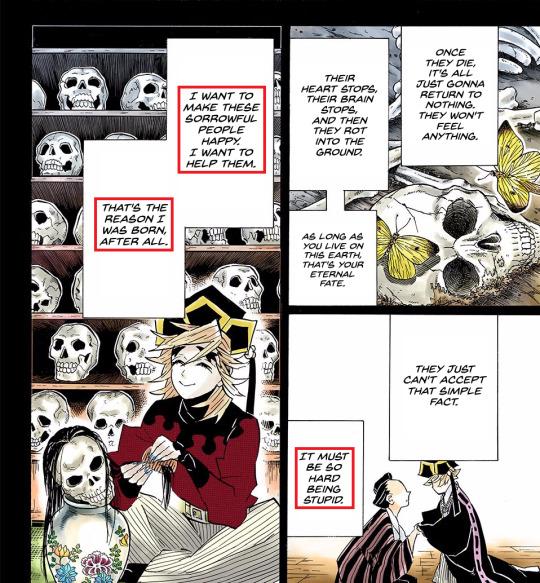

“Once I have attained perfect Buddhahood,
I shall free all sentient beings
From the ocean of Samsara's suffering
And lead them to the freedom of awakening.
For this purpose I shall practise
All the stages of the Bodhisattva's path.
May all beings be happy,
May they be free from suffering,
May they never be separated from their happiness,
And may they realise the state of equanimity,
Free from attachment and aversion.”
Amitabha’s 44 vow:

Amitabha’s 39 vow:

At that time the Buddha called Shariputra to him and said: “If you go from here in the western direction and pass through hundreds of thousands of millions of Buddha Worlds you will come to a world called Sukhavati (Great Happiness). In that world there is a Buddha whose name is Amitabha and who is at this very moment teaching the Dharma.
“Shariputra, why is that land called Great Happiness? Because the people who live there do not have to go through any suffering. They are always enjoying many kinds of happiness. And that is why that world is called Great Happiness.
As you probably know, “sukhavatiI,” the first half of Sukhavativyuha, means “land of happiness,” while the latter half, “vyuha,” means “adornments” or “embellishments.” Thus the literal translation of the title is “Embellishments of the Land of Happiness.” Amida’s Country is a place where everyone, once born there, can find happiness in various ways. As indicated by the title, the sutra describes, with rich Indian imagination, what a very happy land this is.
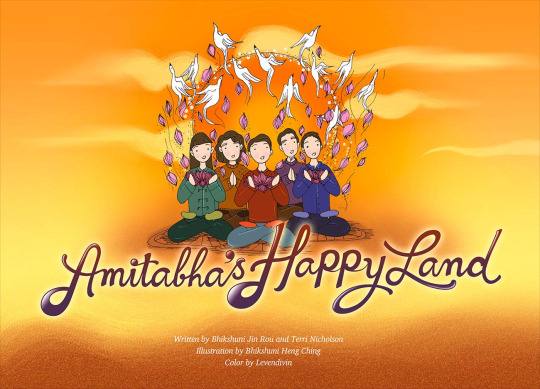
Amitabha is the Buddha of wisdom and compassion. He helps us to live a happy life and to die in peace. The beautiful illustrations in the book take you on a journey through Amitabha's Happy Land with jeweled trees and magnificent birds that sing Amitabha. He made a vow that whoever wishes to be enlightened need only recite his name to be reborn there. In this book, children learn how to recite Amitabha's name and plant a seed for a happy rebirth in the Pure Land. The ancient custom of reciting Amitabha's name carries a message of living life joyfully and accepting death as a natural part of life. With simple words and stunning artwork, this is a book to come back to time and time again.
Limitless Deliverance
Dharmakara takes as his first priority the deliverance of those beings who have the least capacity to leave world of suffering. The First Vow also indicates Amitabha’s compassionate wish to save all suffering beings first. He calls to them:
“All you wretched beings in the Hell Realm, the Hungry Ghosts Realm and the Animal Realms, please, aspire to be reborn in my land and let me take you across the ocean of suffering with my teaching. Then, you will soon become Buddhas.”
As said in the Adornment Sutra, another version of the Infinite Life Sutra:
“All you sentient beings in various realms of reincarnation—come to be reborn in my land and receive endless joy. My kind heart always exerts itself to rescue sentient beings from suffering, and to endlessly deliver all sentient beings in Avici Hell.”
“Various realms of reincarnation” are not restricted only to the hell realms, but also include the hungry ghost, animal, asura, human, and celestial realms. As ordinary beings, we are used to differentiating people by class, nationality, career, and so on. However, in the eyes of Amitabha, all beings are equal since we are all the targets of his compassionate deliverance.
Buddhism advocates great kindness, compassion, relieving others from suffering, and bestowing joy. These are perfectly demonstrated by Amitabha’s teaching of deliverance through his Name, the pristine Pure Land teaching.
We will be deeply moved if we know why Amitabha Buddha gives this vow first place in his master plan of deliverance. Dharmakara makes his priority the deliverance of sentient beings who suffer most and have the least capacity to leave the world of suffering because of their heavy karmic obstructions. Sentient beings may not know or care about the suffering of beings in these realms, but the buddhas do.
Without being asked, Dharmakara proactively made vows to save ordinary beings from reincarnation within the Six Realms as they are likely to fall into the Three Wretched Realms—the animal, hungry ghost, and hell realms—after death. Due to their ignorance, they are inexorably dragged there by their past karma under the Law of Causal Conditioning.
This vow draws the attention of ordinary beings caught in the cycle of birth and death within the Six Realms. It arouses their concern, triggers their intrinsic fear of suffering, and piques their interest to learn more about Amitabha’s Land of Bliss. As Dharmakara Bodhisattva, Amitabha Buddha wished to pacify their minds, and created an ultimate solution for them and all suffering beings.
The First Vow draws the attention of those who, like us, live in the defiled lands and are afraid of falling into wretched realms of suffering after death. The fear of losing our life (or the body of our present incarnation) is hidden deep in the minds of all ordinary beings, because it may happen at any time in the space of a breath.
Since this is the deep and profound concern of all iniquitous ordinary beings in the Six Realms, Dharmakara makes it his top priority to deliver sentient beings who suffer most and have the least capacity to leave the world of suffering because of their heavy karmic obstructions.
“By this effort, may all sentient beings be free of suffering.
May their minds be filled with the nectar of virtue.
In this way, may all causes resulting in suffering be extinguished,
and only the light of compassion shine throughout all realms.”
When Reverend Kuan Yen, the resident nun at Ding Gong Monastery in Quincy, Massachusetts, leads the chanting to Amitabha Buddha and Guanyin, the bodhisattva of compassion, she and the small group of lay members attending the weekly service hope to recite the sutras with such utter sincerity and faith that, after passing from this life, they will be reborn in Sukhavati, the Pure Land of Ultimate Bliss presided over by Amitabha. In this paradise, ten million billion Buddha Lands to the west of the earth, there is no suffering or hardship, only happiness, purity, and safety. The scenery there is spectacular, with precious stones scattered among gently rolling hills, water as sweet as nectar, and magnificent buildings where people gather to practice the Dharma.
The Amitabha Sutra - A Land of Joy without Suffering
Why is this land called Ultimate Bliss?
It is called “Ultimate Bliss” because the sentient beings in this land are free from the myriad sufferings common to mankind, and only know every kind of joy.
“Why is this land called Ultimate Bliss?” is the first question Sakyamuni Buddha posed.
When Sariputra respectfully did not respond, Sakyamuni began to describe the myriad wonders in the Pure Land, starting with its name. The name of the land is Ultimate Bliss because the sentient beings there have overcome their afflictions through mindfulness of Amitabha Buddha. No longer acting from greed, anger, and ignorance or from a mind that has wandering thoughts, discriminations, and attachments, the beings are always blissful. The name of the land reflects this great joy. Thus, the beings in that land are “free from the myriad sufferings common to mankind.”
There is no suffering from the process of birth because beings in the Pure Land are born from lotuses, not from the womb. There is no suffering from old age or sickness because the body is not composed of flesh, blood, and bones. There is no suffering from death for the lifetime in the Pure Land is infinite and concludes in buddhahood. Neither is there suffering of separation from loved ones because beings in that land have no attachments. There is no association with those that one dislikes because everyone is awakened. And there is no suffering from unfulfilled desires because should a being have the thought of something, it will appear naturally.
How to reach the Pure Land
• T’an-luan (the founder of Pure Land Buddhism in China) recommended five practices: reciting scripture, meditating on Amitabha and his paradise, worshipping Amitabha, chanting his name, and making praises and offering to him.
• As pure Land Buddhism developed, the most important practice became reciting Amitabha’s name.
• Pure Land Buddhism offers simple practice and the promise of receiving Amitabha’s help to reach enlightenment.
• This has helped the tradition gain a popular following.
He is worshiped thinking that one can have salvation.
“I make obeisance to Amitabha
The ruby-red Buddha
Of Infinite Light
Who sits in deepest samadhi
Upon a radiant red lotus throne.
To you, Amitabha,
I send forth the goddesses of worship:
Bearing pure sparkling water,
The rarest and most precious perfumes,
Beautiful flowers and pleasing incense,
Lighted lamps and perfumed balms,
Delightful and delicious foods,
And heavenly music which transports the mind”

“I confess whatever ways I have strayed,
Under the power of unawareness from
Amitabha's loving compassion.
I confess all deluded acts of body
I prostrate and give praise to Amitabha's body.
I confess all deluded acts of speech
I prostrate and give praise to Amitabha's speech.
I confess all deluded acts of mind
I prostrate and give praise to Amitabha's mind.”
“I could not understand why would any Buddhist convert to Christianity until I learned about Pure Land. Kinda depressing imo. Seems to confirm that this style of spirituality is not just some random thing that evolved in the Near East. If it emerged independently in East Asia with a completely different set of philosophical axioms, it probably is appears to reflect some sort of universal human drive to submit.
Actually Pure Land developed on the Silk Road, in which Buddhism encountered many religions, including Christianity. One of my old professors maintained the two were not just similar, but that Pure Land was in part an answer to Christianity in the Buddhist dialectic.
Pure Land Buddhism or Amidism, devotional sect of Mahayana Buddhism in China and Japan, centering on worship of the Buddha Amitabha. According to the Pure Land Sutras, composed in India in the 2d cent. AD, Amitabha vowed to save all sentient beings by granting them rebirth in his realm, the Western Paradise, a pure land endowed with miraculous characteristics ensuring its inhabitants easy entry into nirvana. Salvation could be attained by invoking the name of Amitabha with absolute faith in his grace and the efficacy of his vow. It was believed that Amitabha and his retinue would appear to the faithful at the time of death and convey them to his paradise.
In both China and Japan the movement gained impetus from the idea of the end of the Dharma, which divided the development of Buddhism into three ages: that of the true, the counterfeit, and the decaying dharma, that is, Buddhist teaching. Those living in the present final, degenerate age cannot attain enlightenment by the original means of self-effort, austerity, and superior knowledge and must rely entirely on faith. There were devotees of Amitabha in China as early as the end of the 3d cent. AD; the sect was officially founded in 402 by its first patriarch, Hui-Yuan. Later masters spread the faith among the masses, sometimes using evangelical methods, contrasting the torments of hell with the bliss of the Western Paradise.
The Buddha of Infinite Light, known in Japanese as Amida, presided over the Pure Land, the Western Paradise where the faithful could be reborn and gain release from an endless cycle of birth, rebirth, and suffering. Worship of Amida, which reached a peak during the Kamakura period (1185-1333), was promoted by the promise of salvation and also by the Japanese belief that mappo, the final period of decline of the Buddhist Law, had begun in the eleventh century.

“The result was a form of Buddhism accessible to anyone, even if they were illiterate or stupid.”
In Japan, Pure Land Buddhism was established as a sect by Honen (1133–1212), who taught that even those who had mastered Buddhist philosophy should behave themselves like simpleminded folk and renounce all practices except the nembutsu, recitation of the formula Namu Amida Butsu [homage to Amitabha Buddha]. His disciple Shinran (1173–1262) carried Honen's teachings to their logical conclusion by abandoning monastic celibacy and marrying. Shinran held that reliance on one's own effort or on any practice other than the nembutsu would show lack of faith in Amitabha. He broke with Honen's followers on these issues and became the leader of the True Pure Land Sect, which grew to be the largest Buddhist sect in Japan.
Amida (Amitabha) worship is the religious belief based on the Pure Land of Buddhism which believes in justification by belief and preaches that praying to Amida Nyorai would lead you to heaven. It is one of the Jodo Buddhist teachings, but it is a comprehensive belief that transcends sects and could be considered as a folk religion.
Amitabha Nyorai is revered in many Buddhist sects and Amida worship is a wide encompassing belief that is not restricted to one Buddhist writing, but does have an aspect that could easily fall into idol worship or a single-god (only Amida Nyorai is revered) type of thinking.
In medieval Japan, Shin teaching was open and freely available to those who had been excluded from the dharma—illiterate peasants, including women, and those whose livelihood involved impure activities, such as fishermen, hunters, butchers, prostitutes, and thieves. In fact, the popularity of this new teaching so threatened both the Imperial Court and the existing Buddhist establishment—which was scholastic, aristocratic, and monastic—that Honen, who founded the first independent Pure Land school in Japan in 1175—was exiled, along with his chief disciple, Shinran Shonin. Shinran susequently broke with tradition by marrying and raising a family, and establishing a truly lay Buddhist tradition.
Pure Land was a popularized form of Buddhism which preached that salvation could be attained through purely devotional practices, such as the chanting of sutras or brief devotional formulas, the worship of Buddha images, and financial contributions to temples. Pure Land represented a non-intellectual form of Buddhism that appealed most directly to the enormous and illiterate peasant population of China. It taught the poor that through devotion they could escape their lives of misery and be admitted after death to the Western Paradise, the “pure land” where one enjoyed eternal comfort and joy, free of the toils of “ samsara.
Amida worship was first introduced into Japan during the Nara period and mixed together with Miroku Bosatsu (Buddha of the Future, Bodhisattva of the Present) belief as ancestral worship. Later, as part of the flow of Mappo-shiso (the "end of the world" belief), it transitioned into Nenbutsu belief as Amida Jodo Shinko (Amida Buddha in the Pure Land worship) in which people wished to be saved and enter heaven by believing in Amitabha Nyorai.
The veneration of Amitabha represents a significant landmark in the history of Buddhism. It constitutes one of the simplest forms of Buddhist meditation, and for this reason became tremendously popular throughout Asia. The doctrinal basis for the worship of Amitabha, Buddha of the Sukahavati or "Pure Land," is in the Sukahavati-vyuha, a sutra first translated into Chinese in the year 147 CE, though the most famous translations are those by Kumarajiva (344-413) and Xuanzong (600-660 CE).
Amitabha worship made great strides in China during the fifth century, after gaining popularity in Central Asia in earlier centuries. It was particularly widespread among the uneducated, since it did not necessitate any profound knowledge of Buddhist doctrine. Instead, all that was required of practitioners was that they commit themselves to a very large number of repetitions of the name "Amitabha" while simultaneously invoking an inner vision of the Buddha seated in his Western Pure Land Paradise. Anyone who demonstrated his or her faith and total devotion to Amitabha would be granted rebirth in his Pure Land.
Painted images of Amitabha in his paradise provided practitioners with a model upon which to base their visualizations, and were based upon descriptions of the Western Pure Land found in the Sukahavati-vyuha and other sutras. Much like this mural from Cave 251, they usually depicted Amitabha lecturing before a lotus pond (souls of the faithful were reborn inside lotus blossoms), flanked by two attending Bodhisattvas, Avalokitesvara (who bears a miniature image of Amitabha in his headdress) and Mahasthamaprapta (whose headdress is often decorated with a small pagoda). Heavenly musicians and dancers fly above and around Amitabha, rejoicing in his goodness and compassion.
Beginning of the Amitabha Jodo Worship
The origins of Japanese Amitabha Jodo worship started when the last Japanese envoy to Tang Dynasty China, Ennin (794 – 864) of the Tendai Sect came back from Tang and brought Hosho school Nenbutsu of his training place, Mt. Wutai Shan, to Enryaku-ji Temple and built the Jogyo Zanmai-do Hall. The training here consists of chanting Shomyo Nenbutsu for 90 days without rest and thinking and praying about Amida Nyorai (Amitabha Tathagata) deep in the soul.
Thinking about the Amida Nyorai' was 'Kanso Nenbutsu,' the tangible meditative training to reach enlightenment, and was first accepted by the lower class aristocracy. At that time, the majority of important positions in aristocratic society were taken by the Fujiwara clan, hence members of other clans had to wait quietly for their slight chance of getting promoted. This way of living was said to match the feeling of Kanso Nenbutsu where one thinks and adores the image of Buddha.
YOSHISHIGE no Yasutane, a literati of that time who was also a middle class aristocrat, started the Nenbutsu kessha 'Kangakukai' and started to practice Jodo Sect religion.
YOSHISHIGE no Yasutane collected biographies of people who attained gokuraku ojo (peaceful death) by Amida worship and wrote the "Nihon ojo gokurakuki" (Japanese records of birth into the Pure Land).
Later, other books were written following the editing method of "Nihon ojo gokurakuki" such as "Zoku honcho ojoden" (Sequel to the Accounts of Rebirth into the Pure Land) (written by OE no Masafusa), "Shui Ojo-den" (written by MIYOSHI no Tameyasu) and "Sange Ojo-den" (written by Sami Rensho (沙弥蓮祥)).
Using specific actual examples to teach death was extremely effective in spreading the Jodo sect.
As the Jodo sect spread amongst the middle and lower class aristocracy, the Fujiwara clan who were the upper class aristocracy were affected and started to believe in the Jodo sect to take the glory of this life to the next life.
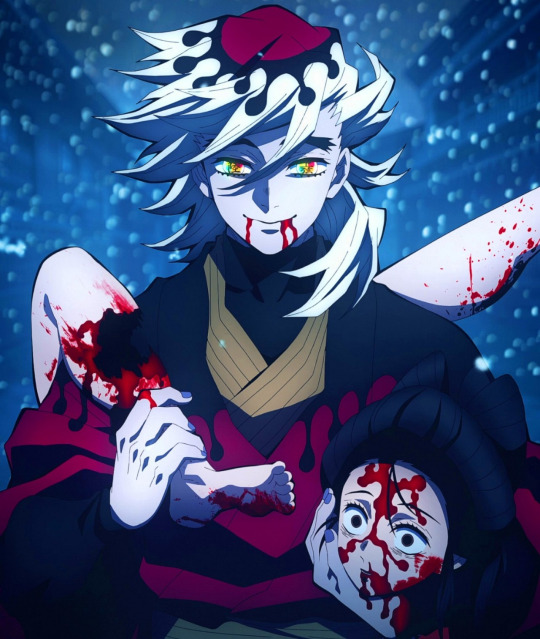

The text from the picture of Amitabha with white hair and red ushnisha is in chinese, so I had to appeal to google translate and it says it means "Guan Yin manifests/appears as Amitabha with white hair". I don't know if it's just a coincidence or if Gotouge knew that there's a manifestation of Amitabha with white hair, but I think it's worth pointing it out.
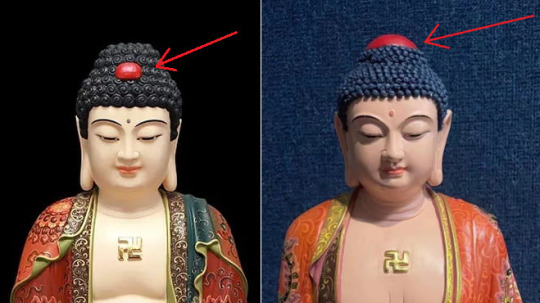
They are intended to symbolize the spirit of the Buddha—his realization and attainment as an ideal to be sought after—and often include features similar to the halos and other signs of spiritual power seen in Christian iconography.
The protuberance at the top of the Buddha’s head is known as the ushnisha, literally “turban.” This is one of the traditional thirty-two marks of the physical body of a buddha (some of which, if taken literally, would make him look pretty monstrous). The ushnisha appears as round, conical, pointed, or flamelike, depending on the sculptural tradition. Most commentators see it is a kind of crown, depicting regalness and the supreme power of the Buddha’s enlightenment. When it’s a flame, it is said to represent spiritual energy.
An ushnisha is the 3-D oval on top of the Buddha's head and indicates the wisdom of the Buddha.
One of the main reasons for this change may be, rather than symbolizing the crown of the royal family, the ushnisha is far better interpreted as symbolizing the spiritual power of the Buddha's enlightenment.
Three Dimensional Oval shaped on the top of Buddha that symbolizes the attainment of reliance in spiritual realm.


When Muzan turned Douma into a demon, he got a red stain on top of his red, which looks like Amitabha's red ushnisha, and he made Muzan the God of his cult religion because he felt so moved by this meeting. The ushnisha is a symbol of the buddha and they get it when they attain enlightenment. Douma got his red stain, this "fake ushnisha", when he met Muzan and attained demonhood, but he prabably thought this was true enlightenment, but since it's not true enlightenment, he didn't get a real ushnisha.
sweet dew (Skt amṛta) In ancient Indian lore, a wonderful sweet nectar that makes the drinker an immortal. In the Mahayana sutras, the teachings of the Buddha are often likened to such sweet dew.
(Skt) A legendary, ambrosia-like liquid. Often translated as sweet dew. In ancient India it was regarded as the sweet-tasting beverage of the gods. In China it was thought to rain down from heaven when the world became peaceful. The word “amrita” means immortality.

This Buddhist painting depicts a ritual in which Buddha ushers all beings to nirvana by giving them “sweet dew” or nectar called gamno (甘露), where the nectar represents Buddha’s teaching of enlightenment. In the Ullambana Sutra (于蘭盆經), one of the Buddha’s closest disciples, Maudgalyayana (目連尊者), found his deceased mother in one type of hell where ghosts are subjected to constant suffering through thirst and hunger. With the Buddha’s help and guidance, he rescued his mother by faithfully following Buddha’s teaching. Paintings like The Nectar Ritual were frequently produced to represent the wish that all the souls suffering from misfortune and disgrace from their previous lives could enlighten themselves by accepting Buddha’s teaching, and thus reincarnate as a superior being in their next life.
While most nectar ritual paintings feature an altar filled with food and a scene from a Buddhist ceremony, this painting dispenses with them. Instead, much of the painting is filled with vivid depictions of various types of karma and their resultant sufferings. The large hungry ghost dominating the center of the painting symbolizes the life of all sentient beings suffering from pain and misfortune. The top of the painting shows a group of Buddhas who seem to be descending to the human world to save the people.
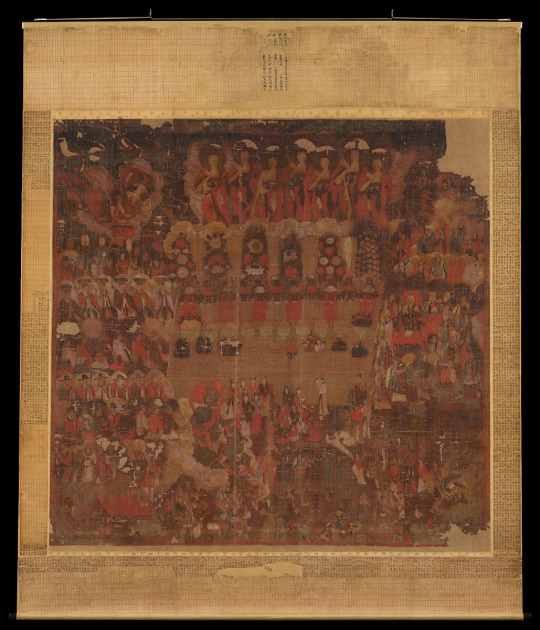
Saving Hungry Ghosts with Sweet Dew
Joseon, 16th century
This work is a rare example of a nectar ritual painting, depicting a Buddhist ceremony intended to save the souls of sentient beings who died in abject misery. A large congregation of wretched souls is gathered to hear preaching and receive offerings of flowers and food, which are arranged on the altar at the center of the painting. Some priests are presiding over the ritual, and in the upper part of the painting, seven Buddhas are approaching to deliver the souls. The painting dates to the early Joseon period, and it was donated by Ejima Kodo, the abbot of Ryuganji Temple in Kyoto, Japan.





Paintings of Amitābha Buddha (Gamrodo)
These paintings portray Amitābha Buddha leading the sentient beings from the hell realms to the Western Pure Land. Amitābha Buddha is depicted as the king of ambrosia or amṛṭa (which literally means "sweet dew"). Ambrosia, or nectar, signifies the teachings, which can relieve the suffering of sentient beings. This painting is also called theUllambana SūtraPaintingbecause it tells the story of Maudgalyāyana liberating her mother from suffering. This painting is sometimes hung on Spirit Altars. Thus, it is sometimes called the Painting of the Spirit Altar, the Ambrosia Painting, or the Magnificent Ambrosia Scroll Painting.
Amitabha has two titles: Ganlu (Sweet Dew) Buddha and Sweet Dew King.
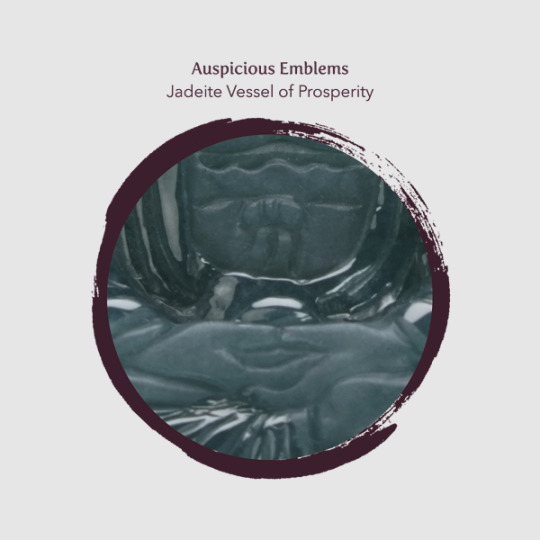
In Buddhist traditions, the Jadeite Vessel of Prosperity is an important artefact containing the divine nectar of immortality, which was used to induct those who had attained Buddhahood into the Land of Pure Bliss, thereby signifying the fulfilment of spiritual wishes.
The Jadeite Vessel of Prosperity rests in the palms of Amitabha Buddha, who uses this vessel to bless his destined devotees with auspicious luck in times of need so that they may immediately address any challenges or obstacles that hinder their paths to success.

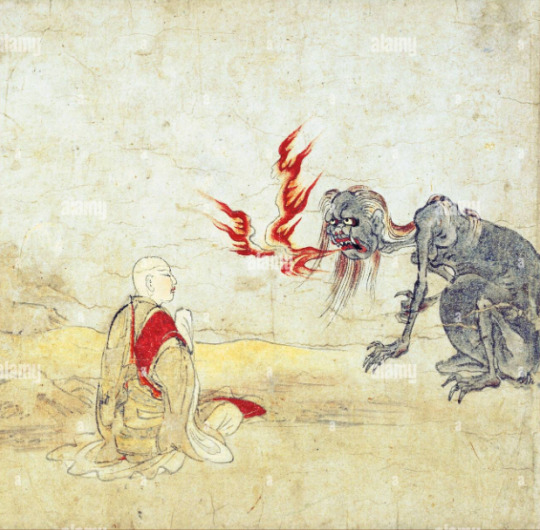
"Hungry ghost" is one of the six modes of existence (see Six Realms). Hungry ghosts are pitiable creatures with huge, empty stomachs. They have pinhole mouths, and their necks are so thin they cannot swallow, so they remain hungry. Beings are reborn as hungry ghosts because of their greed, envy and jealousy. Hungry ghosts are also associated with addiction, obsession, and compulsion.
'Envy is a hungry ghost with a pinhole mouth'
In Buddhist cosmology, one of the psychic domains that is described is the Realm of the Hungry Ghosts. The hungry ghost figures are depicted with scrawny little necks and huge bellies — riddled with powerful desires they can never really satisfy. Nearly everyone I know struggles with their own version of the hungry ghost syndrome.



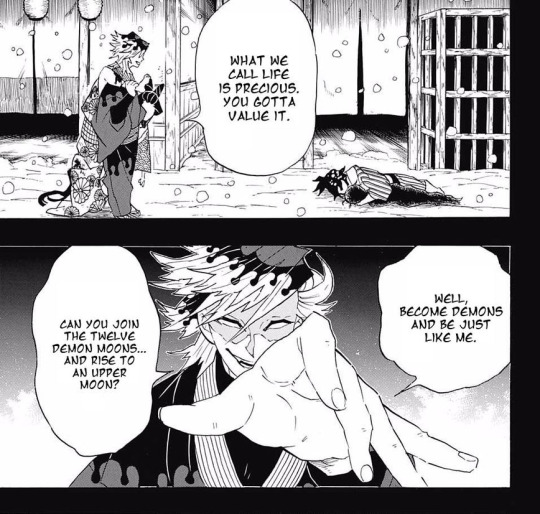
Considering that sweet dew is a substance of the Gods that grants immortality and satisfy hungry ghosts' hunger, it's not wrong to equate it to Muzan Blood. Muzan would take advantage of human desire and give his blood to people who couldn’t satisfy it in their human lives. Most of them were like hungry ghosts because they were consumed by negative emotions like greed, jealousy and envy like Gyutaro. In this sense, giving them Muzan Blood is like making a Sweet Dew Ritual.
Hungry ghosts are also the result of compulsions that couldn't satisfy a deeper desire. When Muzan gives Douma his blood, his hobbies are driking alcohol and smoking, so he was probably an addict. When Douma gives Gyutaro Muzan Blood, he's already deeply consumed by envy, at everyone who has anything better than him. Not only does Gyutaro acts exactly like a hungry ghost, he also looks like one.



This is more like a peesonal theory of mine, but I think Gyutaro's design was inspired by the hungry ghosts to some extent. His characters is also all about envying everyone who has a better life or anything than him, which is a certain way to become a hungry ghost. There's even the popular saying "Envy is a hungry ghost with a pinhole mouth". His grayish skin tone and scrawny body makes him look a lot some hungry ghosts I saw in the pictures. He was given Muzan Blood by Douma in what looks like a Sweet Dew Ritual to save hungry ghosts, if you equate Muzan Blood with sweet dew. He also put The Red Light District on fire and made it look like hell, and the many pictures depict hungry ghost in a fiery hell. It's also worth noting that hungry ghosts are also often depicted burning/on fire and Daki was burned alive.
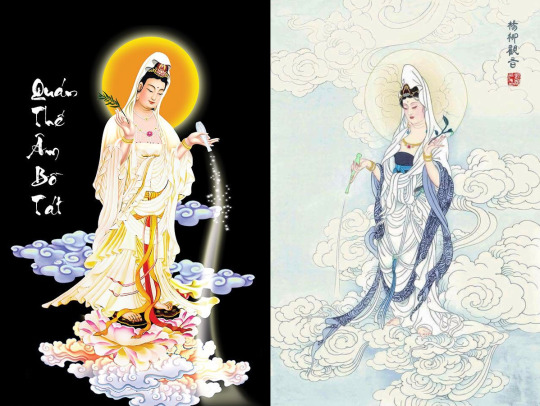
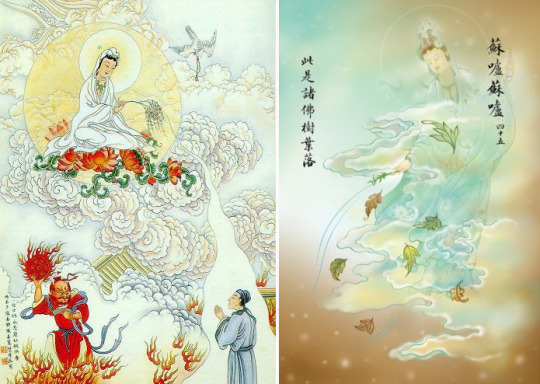

Back to the main topic, the White Blizzard Princesses. So I already stablished that the "giant buddha" was actually Guan Yin, one of the white blizzard princesses, and that the freezing air was the sweet dew she sprinkles everywhere from her vase and willow brach. You could say that the white blizzard princesses are a smaller version of the water lily bodhisattva. But what about Mashthamaprapta? Well, both are Amitabha's attendants, who is known as the king of sweet dew, used to be princesses, are dressed in white in many depictions and are said to be identical except for a few ornaments so both should have the same competences.


Concealed in Seishi's head-dress, behind his diadem but before his ushnisha, stands a kanro-byo, or nectar-vase, of gold containing the amrta, or elixir of immortality. Seishi is sometimes given the epithet Son of the Moon, and this establishes his relationship to Candra, the Hindu moon-god, who also dispenses the soma, or nectar of deathlessness, from his lunar cup.
On the completion of the Ascending Realization, when Kundalini, the Serpent Power, rises from the muladhara chakra, or lowest centre, to the sahashrara-padma, or Thousand-Petalled Lotus at the crown of the head, the amrta spills over and flows down again to the Heart-centre, or anahata-cakra, in the bliss of Descending Realization. The overflowing of the kanro, or elixir, from Seishi's vase forms the Mahayana counterpart of this and provides the joy felt by the Bodhisattva on making his Vow to return to this world to rescue all sentient beings.
The bodhisattva is identified by the nectar vase in the open work tiara.
Mystery solved. Seishi/Mahasthamaprapta has a vase filled with sweet dew in their tiara, which looks exactly like Guan Yin's, and they sprinkle the sweet dew inside it to the entire physical realm, also exactly what Guan Yin does. So it's not hard to see why they're paired with Guan Yin as a White Blizzard Princess, it might not just be about them looking the same.

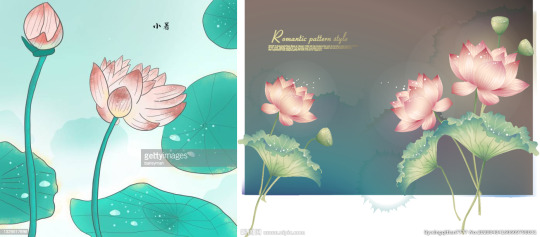

Lotus Ice
After all this research, I've started to think that the particles or fog coming out of ice lotus flowers is actually sweet dew. Amitabha, known by many as the king of sweet dew, is almost always depicted holding a lotus flowers. And apparently Kṣitigarbha or Ti-tsang, another bodhisattva like Guan Yin and Seishi, was able to make sweet dew flow out of a lotus to feed hungry ghosts.


According to this, there's a "mudra/mantra of sweet dew" that if performed any monk can turn normal water into sweet dew. But Douma seems more than just a normal monk, he seems to be a parody of Amitabha, who's almost always portrayed carrying a lotus flower and is known as the king of sweet dew.


Amitabha's vessel of sweet dew he has in his hands, which grants immortality, is almost always portrayed as a lotus flower. The bodhisattvas can make it rain sweet dew in the entire realm and it makes the plants wet with sweet dew.




When I search for sweet dew(甘露), I'm very often greeted by poctures of lotus flowers and other plants, many times with "甘露" written somewhere in the picture. It also almost always happens when the article is explaining the mantra of the sweet dew/nectar.








The first site about the nectar/sweet dew mantra translated it as "dandruff nectar", but other sites translate as "corns of nectar". Both terminologies can work with Douma's Lotus Ice because Shinobu described it as a fog, but it looks like corns of something. The sites say that any practitioner of Pure Land Buddhism can turn water into sweet dew with this mantra. Bodhisattvas can make it rain sweet dew and it wets the flowers and normal people can turn water into sweet dew/nectar and plants are a great source of water and nectar.



If it's not sweet dew, it could be pollen. The pollen produced by plants looks like dandruff, if you look at the first picture. Some plants unleashes massive pollen clouds that can engulf an entire city and it can be deadly for people with pollen allergy. But the huge pollen clouds unleashed by plants remind me of Douma's fog of freezing air.
And now spoilers for Naruto:

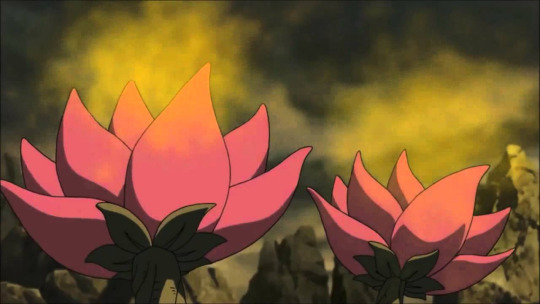


Gotouge was inspired by many shounens when making KnY and one of the inspiration was very likely to be Naruto. There's a very important character from Nature who has long hair, is dressed in red and whose main purpose was creating a place without war where all ninja clans could live in harmony. This place was later called Hidden Leaf Village. This reminds me of Amitabha, in a good way, because he also dresses in red and created a paradise called Pure Land where the sufferers would not suffer anymore.
But most importantly, Hashirama's attacks are based on buddhism elements. This featured attack above is called "wood style: deep forest bloom" and unleashed, lots of lotus flower appear and realease pollen everywhere. When that happens, you can't get close to the person who unleashed it because of the pollen. A similar situation to Kanao not being able to get too close to Douma for long because of the freezing air happened in the Naruto manga/anime when the villain Madara used it against the good guys the 5 kages, they had to keep their distance.

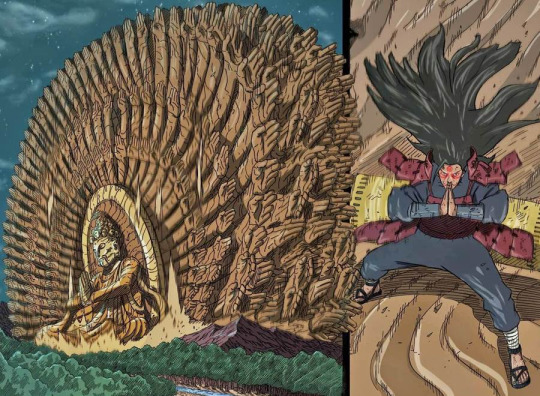



It's worth noting that, much like Douma, Hashirama can also summon Guan Yin, but her evolved form "The One Thousand Armed Guan Yin", not her basic form that Douma summons. And since this is a series from Japan, Guan Yin is addressed as Kannon, so it's One Thousand Arms Kannon" or "Senju Kannon(千手観音)". Hashirama seems like a healthy inspiration from Amitabha. Douma and Hashirama even have the same MBTI and enneagram(ENFJ 7w6 729 so/sx). Netero from Hunter x Hunter can also summon Guan Yin/Kannon, so you can see that most characters who summon her are great heroes and it's very uncomfortable to see such a villanous character summon her.
#doma#douma#kny doma#kny douma#kimetsu no yaiba douma#kimetsu no yaiba doma#gyutaro#muzan kibutsuji#kotoha hashibira#pure land buddhism#amitabha#guan yin#guanyin#kuan yin#avalokiteshvara#mahasthamaprapta#naruto shippuden#hashirama senju#madara uchiha
212 notes
·
View notes
Text
youtube
#buddha#amitabha#amitabhabuddha#amituofo#buddhism#buddhist#namoamituofo#namuamidabutsu#pure land#pure land buddhism#Youtube
2 notes
·
View notes
Text
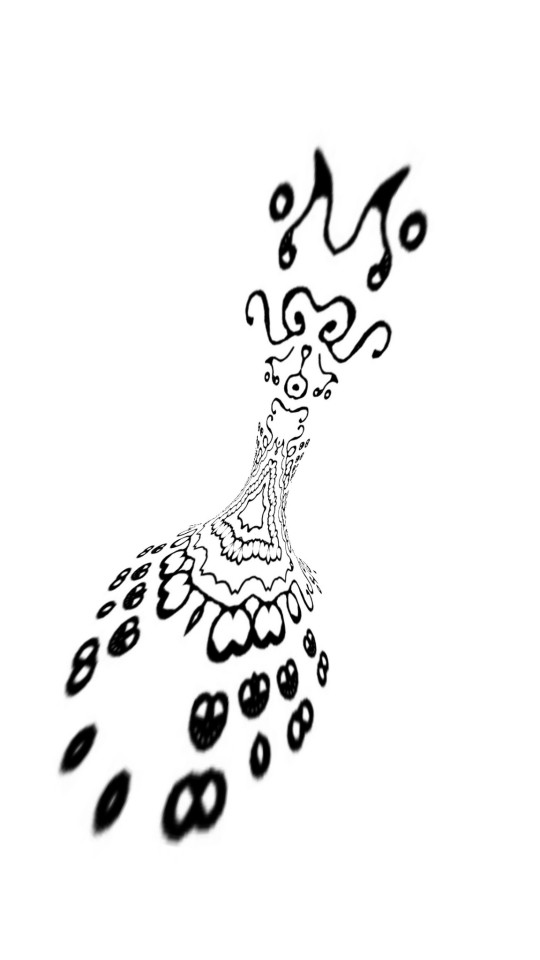
⚡Positive Mental Event⚡
[Vajra_Aspect : HRIH]
Highest spiritual activity
Have compassion for yourself
#inner voice#solar aspect#gather accomplishments#self esteem#confidence#wisdom#Tibetan sorcery#seed syllables#hrih#compassion#amitabha#breath of fire#power activation#digital talisman#cyber altar#hypervisual#multidimensional#meta sigil#parapattern
8 notes
·
View notes
Text
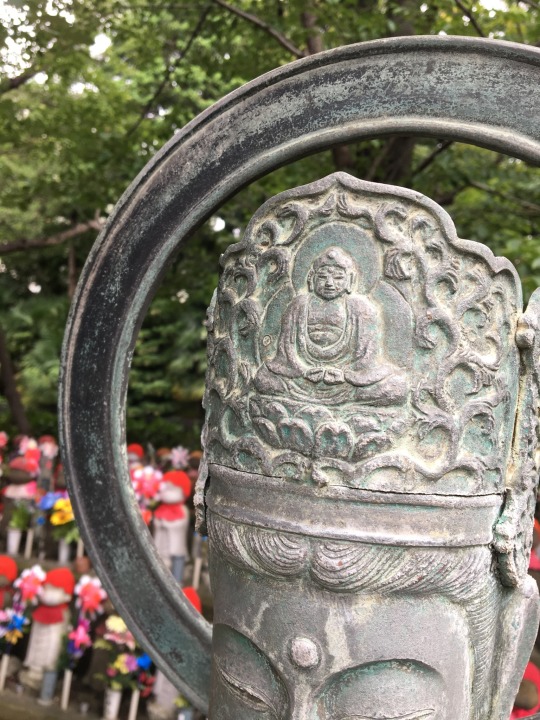

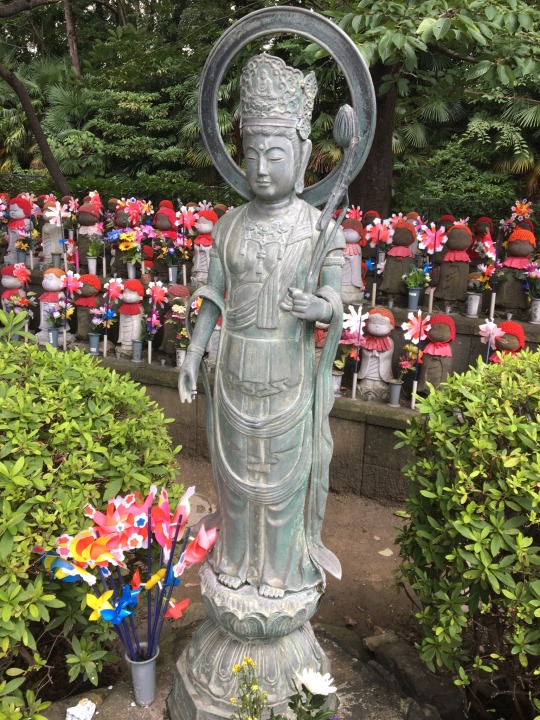
Kannon (Avalokiteshvara Bodhisattva) statue at Zojoji Temple in Tokyo, Japan. Note the crown with an image of Amida (Amitabha) Buddha. Kannon is said to be an attendant of Amida Buddha. 南無阿弥陀仏.
11 notes
·
View notes
Text
The Amitabha Pure Land Rebirth mantra

The Amitabha Pure Land Rebirth mantra is a mantra that is commonly recited in Pure Land sect ceremonies. It is used to pray for liberation for the souls of the dead, with the ability to destroy all basic karma - things that we do wrong, causing harm to others. The Rebirth mantra helps us to eliminate bad karma, prevent afflictions from arising, so that we can be happy and happy in the present and in the future.
14 notes
·
View notes
Photo

Returning to new york is always great! It’s always special to run into friends while out and about. I ran into this cool cat on my way to a fitting last week for some background acting stuff this week. If you see Gabe while you’re also out and about, tell him I said 👋🏽 hi! 🎷💪🏽🤟🏽 #musicundernewyork #muny #streetmusic This is good buddy @galdort We’ve been makin music for over a decade! You can see us with his fin New Orleans style band in a few weeks at The Bitter End, Fri 3/24, 11pm! Come through and hang! It’s always and adventure! #justgladtobehere #saxophone #bass #drums #guitar #vocals #soul #funk #jazz #livemusic #music #goodvibes #followyourbliss #amitabha #infinitelight #mabuhay #mahalo #live#music #ikigai #livemusic (at Times Square, New York City) https://www.instagram.com/p/Cpfw1SeJBG3/?igshid=NGJjMDIxMWI=
#musicundernewyork#muny#streetmusic#justgladtobehere#saxophone#bass#drums#guitar#vocals#soul#funk#jazz#livemusic#music#goodvibes#followyourbliss#amitabha#infinitelight#mabuhay#mahalo#live#ikigai
4 notes
·
View notes
Text

Religious Studies Term Of The Day: Sukhavati
#religiousstudies#religious studies#religion#religiousliteracy#religions#women and religious traditions#leona m anderson#oxford#pamela dicky young#Eva k neumaier#buddhism#buddhist#pure land buddhism#buddhist wisdom#buddhist teachings#Sukhavati#buddha#amitabha#pure land#Buddha amitabha#factsdaily#fun facts#factoftheday#big facts
2 notes
·
View notes
Text
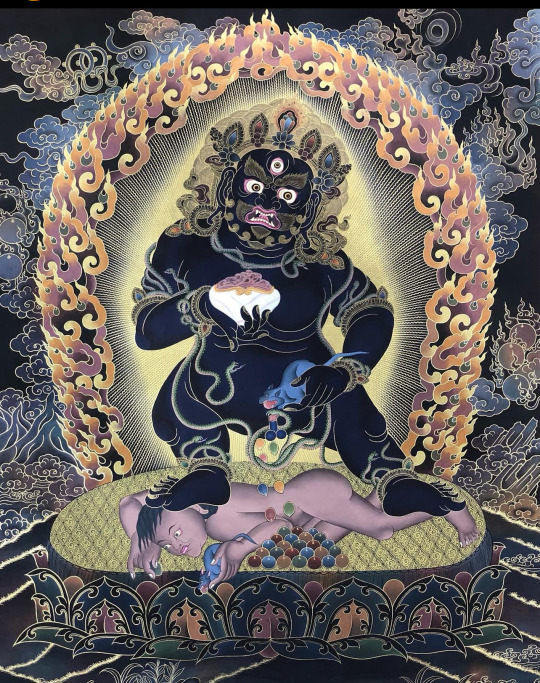
Zambhala has a type of enlightened energy that purifies misery Karma. Zambhala helps one to collect the merit in order to achieve that and purify the demerit that stops you from achieving that.
If one practice Zambhala practice correctly one become less miserly, less greedy, less selfish.
#buddha#buddhist#buddhism#dharma#sangha#mahayana#zen#milarepa#tibetan buddhism#thich nhat hanh#dakini#dzogchen#amitabha#four noble truths#Padmasambhava#Guru Rinpoche#manjushri#Dzambala
27 notes
·
View notes
Text

A painted image of seven deities dating to the Kamakura period (1185-1333) at Tōji Temple (東寺) in Kyoto: on the left, Fugen Bodhisattva (普賢菩薩) & Jizō Bodhisattva (地蔵菩薩); in the middle, Amida Buddha (阿弥陀如来) & Shakyamuni Buddha (釈迦如来) & Yakushi Buddha (薬師如来); on the right, Kannon Bodhisattva (観音菩薩) & Fudō Myōō (不動明王)
Image from "東寺の菩薩像" [Images of Bodhisattvas at Tōji] published by 東寺宝物館 [Tōji Treasure Museum], 1993, page 55
#japanese art#buddhist art#京都#kyoto#東寺#toji#普賢菩薩#fugen#地蔵菩薩#地蔵#jizo#阿弥陀如来#amida#amida nyorai#amitabha#釈迦如来#shaka nyorai#shakyamuni#薬師如来#yakushi nyorai#yakushi#観音菩薩#観音#kannon#avalokitesvara#不動明王#fudo myoo#真言宗#shingon#crazyfoxarchives
42 notes
·
View notes
Text
You think I'm a good person?
If I were a good person, I would be able to accept the Buddha's wisdom without a shred of doubt.
If I were a good person, I would not delight in poison.
If I were a good person, I would do good selflessly, benefiting friends and enemies alike.
And if I were a good person, I would be free. I am not free.
I'm not a good person. That doesn't mean I'm some kind of serial killer or sociopath, going around manipulating and exploiting people for my own gain. But I live my life selfishly. I do things which should not be done, think things which should not be thought, and say things which should not be said.
It is because of this, not in spite of it, that Amida's Vow is the only path for me. I will not accomplish the Buddha Way. I cannot make the Bodhisattva Vows honestly, knowing I won't fulfill them. And this is precisely what makes me the target of the Vow. It actually makes it EASIER to go to the Pure Land because the Path of Birth Through the Nembutsu is designed that way. Shinran states "Even a good person can make it to the Pure Land. How much easier it is for the evil person to get there!"
My karma is heavy. I regret myself. Namu Amida Butsu.
21 notes
·
View notes